Read the blog
The 5 Remembrances Tarot Spread
Sometimes I encounter a tarot book and I think “wow, we really need more of this.” That was my reaction when I heard about Theresa Reed’s latest, The Cards You’re Dealt: How to Deal When Life Gets Real. Here, card meanings and activities are tailored for navigating the biggest challenges in life: grief, loss, caretaking and other destabilizing events.
Could this release have been more perfectly timed? I don’t think so.
Theresa’s signature blend of directness and empathy is what makes this book special. She talks about topics that many of us shirk away from with directness and clarity. At the same time, her tone is compassionate and centered. She knows who she is as a tarot reader and has years of experience to back it up, yet never presents her perspectives as THE way, but A way.
There’s a particular spread in the book that called out to me, so I want to try it for myself and share it with you here today. Theresa writes:
Buddha recommended meditating or reciting the Five Remembrances, also known as Upajjhatthana Sutta, to remember that life is precious and finite. This practice helps alleviate grasping and attachment. Here is one version of these remembrances:
I am of the nature to grow old; there is no way to escape growing old.
I am of the nature to have ill health; there is no way to escape having ill health.
I am of the nature to die; there is no way to escape death.
All that is dear to me and everyone I love are of the nature to change. There is no way to escape being separated from them.
My deeds are my closest companions. I am the beneficiary of my deeds. My deeds are the ground on which I stand.
I took the liberty of creating a graphic to show Theresa’s spread based on this concept.
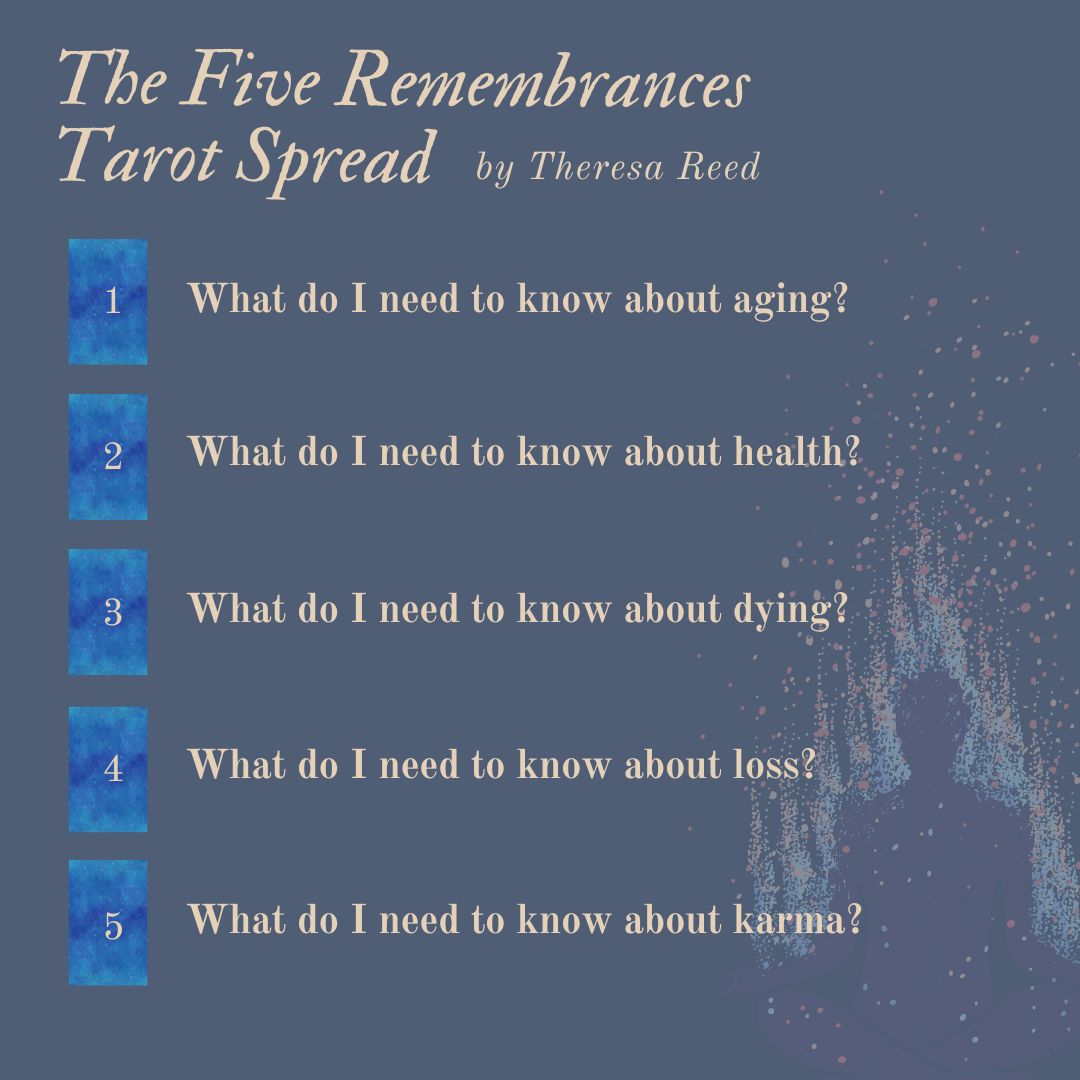
Let’s try it. As usual, I’m pulling cards for myself but maybe you’ll find something that resonates with you. And I hope you’ll be inspired to do the spread for yourself, too. I’m gonna use a deck which has been gathering dust for far too long, the Prisma Visions Tarot.
The Tower reversed suggests what I need to know about aging and my immediate thought was this: aging doesn’t have to be bad or scary. I think sometimes we focus on the wrong fears around aging. Like, wrinkles aren’t actually scary. Gray hair isn’t scary. Sure, some parts of aging ARE scary. Organs and joints and other body parts degenerating or losing function, THAT is scary. But so much of what we think about when we think about aging really… isn’t?
Who benefits from aging being viewed as scary? Capitalism, baby. Cuz corporations can sell us endless serums and injections and shapewear and whatever the hell else. I mean, I love my skincare routine as much as the next American Elder Millennial but come on.
I think the Tower also shows the liberation that comes with aging. For me, the older I get the less fucks I have to give about things that concerned me more when I was younger. I hope this will be a continuing trajectory.
Justice reveals what I need to know about health. I have to admit, this does not immediately click for me. The imagery in this deck leans heavily into the ‘cause and effect’ interpretation: a serpent bites a hand, yet this results in the serpent being stabbed by the dagger the hand holds.
I acknowledge there is some element of cause and effect with health: certain lifestyle choices are linked to certain ailments, blah blah. But this gets complicated quickly. Not everyone has access to ‘healthy lifestyle choices’. We can’t all afford the best food, we don’t all have the luxury of low stress, and so on.
Then there’s the fact that sometimes even if you do everything “right”, even if you make the best choices you can, this does not guarantee good health. This leads me to consider the theme of impartiality that is also commonly attributed to Justice. Perhaps that is relevant here. Health issues don’t always arise for a discernible reason. There isn’t always a clear cause. Sometimes shit just happens.
The Six of Pentacles shows up for what I need to know about dying. This card can represent the resources we have and how those are distributed. In this deck, one person passes a coin to another. In a way, isn’t that kind of what dying is? I can’t take up resources forever. Eventually, I return to the soil so that new life can access the bounty of this universe.
It also reminds me all life is made of the same stuff. Always has been and always will be. Like, the water molecules inside me right now could be more than 4.6 billion years old. Someday in the future the chemical components that currently make me could be in a flower or a bear or a new planet.
I pulled the Ace of Chalices for what I need to know about loss. This is a beautiful card. And I hate to say it because it sounds so trite, but maybe it is reminding me that loss can be beautiful. If I’m feeling loss, it is because I cared deeply about someone or something. It’s been said a million times that the only way not to experience loss is not to experience connection. Loss and connection flow from the same spring. They are both deep, primal emotions and they cannot be separated.
What do I need to know about karma? DEATH. Let’s take a moment to appreciate that I had Death AND the Tower show up in this reading. Lucky me.
Irreverence aside, it is interesting considering a card that represents karma when earlier in this reading, when talking about Justice, I more or less said I don’t believe in karma. I suppose I should clarify. I don’t think it it impossible that on some cosmic level that transcends lifetimes, “my deeds are the ground on which I stand.” In fact, I actually kind of like this idea.
I guess what I don’t resonate with is the notion that I can completely understand or control my karma, or that I will see it play out in this lifetime. And in that way, maybe the Death card makes a lot of sense here, because it can be a card of letting go. All I can do is try to live this life with as much integrity as I can muster in each moment. What happens from there isn’t up to me.
This whole concept of meditating on the Five Remembrances was described as a way to “alleviate grasping and attachment.” And that is exactly what the Death card is about.
Wow! What an interesting and illuminating spread. I extend my gratitude to Theresa Reed for creating this.
And thanks to YOU for being here. Let me know what you think?
Carrie
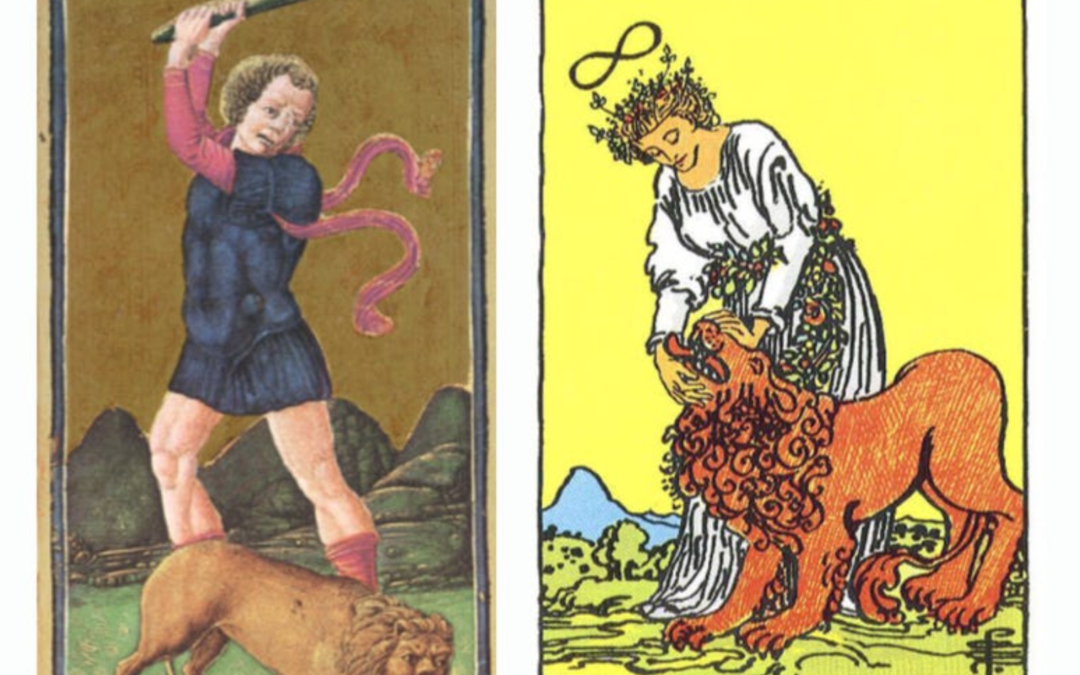
Give Me Strength
I need it. You need it. We all need it. Strength. Our collective card for the year of 2024. How can we make sense of this card? What context does it offer to our current time and space? Let’s open an inquiry.
Part One: Origins and Evolution of Strength
As someone who came to tarot through the Waite-Smith tradition I’m accustomed to a gentle version of Strength, a woman calmly attending to a lion. Patience and compassion were among the first key words I associated with this card (shout out to Joan Bunning for that). But when I delved further into tarot history I realized the earliest illustrations were quite different, showing a man (Hercules, most likely) beating a lion with a club.
This juxtaposition in themes of violence and gentleness seems as relevant a place as any to begin talking about our card of the year for 2024. With either of these viewpoints, you could say Strength is about facing something difficult. Perhaps this year asks us individually and collectively:
What difficulties are you facing internally and externally? Will you respond with force and violence, or patience and gentleness? Or perhaps some combination thereof?
There’s also the question of perception and framing here. What one person perceives of as gentleness might be perceived by someone else as violence and vice versa. Things aren’t always what they seem.
In the earliest decks, like the Visconti-Sforza shown above, the card was titled Fortitude and is one of the classic cardinal virtues. Wikipedia defines Fortitude as “the ability to confront fear, uncertainty, and intimidation.” To add even more nuance, the virtue of Fortitude requires patience. It isn’t just about charging into a quick battle and mowing things down. True Fortitude asks you to pace yourself so you can be present for the long-haul, not just the current crisis.
But it’s also important to note that pacing yourself doesn’t mean looking away. Fortitude, or Strength, asks us to stay present with fearful and uncertain circumstances. In some moments, being present might mean taking direct action, doing something. In other moments, staying present is simply continuing to bear witness.
In my last couple of posts I talked extensively about the book Forest of Souls by Rachel Pollack and guess what?! I saved more for THIS post because Rachel shares some great insights on the development of the Strength card.
In particular, she considers how the image of Hercules quickly became replaced by a woman with a lion in the Marseille tarot. Rachel writes:
“The image of a woman with a lion is in fact extremely old, far older than Hercules and his thick club. In fact, the Hercules story might have represented the need of the warrior Greeks to subdue an older, more indigenous culture, one centered on a Goddess. The image of a female deity with big cats goes back at least eight thousand years to a small statue excavated in Turkey. A powerful woman sits on a chair and gives birth, without struggle, while leopards lie on either side.”
She goes on to share several other historical cultural connections between women and lions/great cats (the Egyptian Sphinx, the Indian goddess Durga and more).
In a different book, Tarot Wisdom, Rachel studies how definitions of the Strength tarot card have evolved over time. The earliest interpretations were about force, power, and vanquishing the untamed. Yet if you are familiar with any modern tarot interpretations, you’ve surely seen this card described as a gentle touch. The woman on the card, it is often said, befriends the lion. Tends to it with care and understanding. Seeks to calm and soothe it, not beat it into submission. Rachel writes:
So where does that idea of gentleness come in, of feminine passion? Maybe it literally comes from women, and modern women at that, the many who have helped shape tarot interpretation over the last (several) decades. One of the earliest of these modern interpreters was Eden Gray, author of several Tarot books in the late 1960s-70s, who says about Strength: ‘force of character, spiritual power overcoming material power, love triumphing over hate…’
It is always interesting following the threads of thought that form our modern conceptions of tarot cards. And I really value giving credit to people like Eden Gray whose influence is always present, but not always acknowledged by modern tarot readers.
Part Two: is it REALLY a Strength year tho?
It’s worth mentioning that for some tarot practitioners, 2024 is not a Strength year at all, but a Justice year. Justice was card 8 and Strength 11 in the earlier numbering of the major arcana. It was Arthur Edward Waite and the Golden Dawn who made the switch to better align with their astrological correspondences. I kind of love the attitude Waite gives when acknowledging this in The Pictorial Key to the Tarot:
For reasons which satisfy myself, this card has been interchanged with that of Justice, which is usually numbered eight. As the variation carries nothing with it which will signify to the reader, there is no cause for explanation.
Y’know, the next time someone asks me why I prefer some method or another when it comes to tarot I might just reply “for reasons which satisfy myself” and leave it at that.
Anyway, I learned with the Golden Dawn numbering, and even though I don’t really incorporate astrology into my tarot readings, I think Strength is a more natural fit as card 8. There’s a couple reasons for this. The first is that as I mentioned in my post on 2023’s card, the Chariot, I learned to consider Strength + the Chariot as a pair. As such, it seems natural for Strength to follow the Chariot.
The second is another thing Rachel Pollack points out (I’m mentioning her again…what a surprise!), which is that the Golden Dawn numbering puts Justice right at the center of the major arcana, giving it a pivotal role. That gives me shivers and just feels right. There’s much more to be said about this, but that’s another topic for another day.
Most modern decks use the GD numbering, but there are exceptions. I famously wrote a whole series on the Wild Unknown tarot, a modern deck which reverts to the old numbering of Strength as 11 and Justice as 8. As with most things in tarot, take on whichever numerology resonates with you.
Part Three: Where do we go from here?
As I consider how Strength fits into the context of 2024, I keep coming back to the notion of energy conservation. I talked a little about this earlier. Pacing yourself to be present for the long haul.
That was on my mind when we created our version for The Spacious Tarot. The cactus exists in a harsh landscape. Water is scarce and cannot be wasted. The plant has adapted to this landscape and treats every bit of moisture as a precious gift. The sun is harsh and survival is not easy, yet a bloom appears.
Many of the problems we face in 2024 do not have quick solutions. Mass violence and oppression, climate change, resource hoarding…none of this is new. Much of it will be impossible to solve this year. But that doesn’t mean we stop trying. We keep going, but we monitor our energy. We do what we can to make our actions and reactions sustainable. Easier said than done, but perhaps that is one of the callings of Strength this year.
And yet a bloom appears. This is true not only in the Spacious Tarot illustration, but in the Waite-Smith as well. The woman is connected to the lion by a chain of flowers. This is a reminder that beauty and tenderness can and do exist alongside horror. It is a somber thing, facing difficulties. But it is a precious thing as well. Cherish the moments of laughter and thriving this year. Even when they are small, they matter immensely. That’s part of conserving your energy for the big picture.
The other day I saw a clip of Fiona Apple talking about how our brains are wired to remember difficult things. It’s a survival mechanism. I know this and I think about it often. She went on to say that it’s helpful to make an effort to remember good things as well. She says that any time you experience something good, no matter how small, take at least 30 seconds to dwell on it and relish in the experience, so it becomes embedded in your psyche. Try this with your flowery moments this year.
Going back to the Waite-Smith depiction, I’m intrigued by the expression on the person’s face. They don’t appear scared or angry or even tired. Yet they don’t appear happy or peaceful, either. To me, their appearance conveys acceptance. Here I am. I’m in this reality. I may not like it. It may be brutal. But I’m here and I will do what I can.
And so it is. I ask for Strength for myself, and for you, and for us all. May we keep showing up.
Carrie
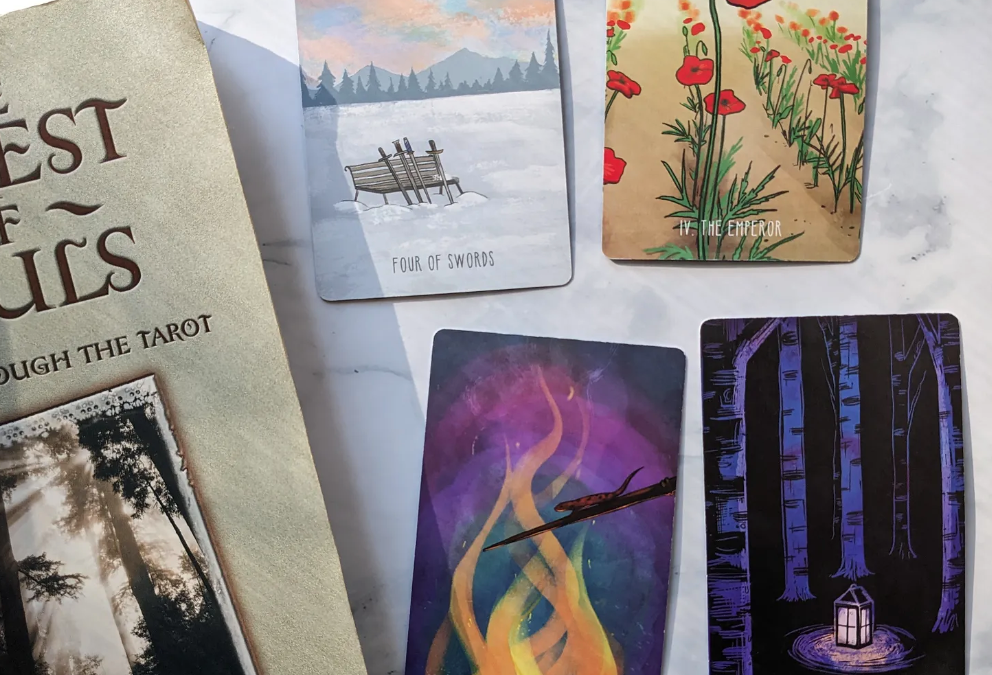
Entering the Forest of Souls (part two)
I kind of want to live in the book Forest of Souls by Rachel Pollack. Instead, I’ll continue to share some of my favorite passages with you. You don’t HAVE to visit part one first, but that would offer some context, find it here.
When we left off, Rachel Pollack was imagining which cards God may have received, if God used a tarot reading to create the world. No big deal. There’s an observation here that I really like even plucked out of context:
We function best with people when we don’t try to tell them about themselves (‘you know, you’re very defensive. You need to face the truth’) but instead genuinely listen to people and then speak as honestly as possible about ourselves.
This is so true and something so many of us human beings need a reminder of. Imagine the shift in energy this sentiment can bring to interpersonal relationships. Of course, it is also wise advise for anyone who reads tarot for other people. A reading can come across as condescending when the cards are used to tell someone about themselves. And a reading can be transformational when the cards are used not to be prescriptive but to truly listen, to truly connect on a human level.
~~~
Here’s a poignant little insight on the Five of Cups (or Five of Rivers as it is titled in Rachel’s deck the Shining Tribe Tarot).
The Five of Rivers concerns consciousness that can emerge from loss. In other words, through sorrow we gain new understanding…. to unlock mysteries… part of the process demands that we accept sorrow as a path to wisdom.
This reminds me of one of my favorite quotes from Khalil Gibran: “the deeper that sorrow carves into your being, the more joy you can contain.” I reference this quote frequently in association with the Three of Swords, but the Five of Cups covers similar ground.
This hits particularly hard for me right now as I’m going through one of the greatest sadnesses of my life. Now, I don’t want to romanticize sadness. I don’t want to do a ~*spiritual bypassing*~ and claim that sadness is a great gift, actually. But if you are living your life with any amount of awareness and connection, you will encounter great sadness. It is not avoidable. And I guess for me, I like the idea that understanding can come through sorrow. It makes it a little more endurable to sit with the sorrow. I’m not yet sure what the new understanding is for me at this time, but I’m open to experiencing it when the tide is right.
~~~
Shifting gears, Rachel has this to say about the rules of tarot, and I heartily agree.
Something I’ve learned over the years I’ve worked with tarot is to give myself permission to break the rules, even the ones I make up myself.
Mic drop, eh? I came across a similar sentiment in the Tarot Celebrations book I talked about in my golden shadow post. The authors suggest that the only rule you need to read tarot the “right” way is to approach your cards with “an open mind and an open heart.”
I’ve been in the online tarot space long enough to know that there are in fact still people out there who are very insistent on their tarot rules and those people become extremely annoyed if you have a different philosophy. One of my favorite examples was when someone talked shit on me for suggesting it’s okay to remove cards from your tarot deck. I don’t play by your rules, or even my own. Stay mad.
~~~
In another of her wisdom readings – the phrase Rachel uses to describe readings on intricate spiritual topics – there’s some insights on the Justice card that stood out to me.
Justice calls on us to be totally honest and recognize who we are… we need to act with complete integrity, a commitment that demands more of us than simply following the rules of social morality… Justice occupies the exact middle of the Major Arcana. This makes it a crucial point, either a barrier or a gateway, depending on how we approach it.
I’m not sure where I originally encountered the association of Justice with integrity, but it has been one of my core themes for this card for many years. Any time there is a horrible atrocity happening in the world (which unfortunately seems to be…like…all the time) I consider this. Obviously I value listening and learning from other people. But I also want to make sure that I’m in integrity with my own perception of a situation, not just falling into the ‘socially acceptable’ opinion.
That can be complex, but it can also be really simple. It is integrity for me to believe that every human being deserves peace and dignity. It is in integrity for me to say that oppression to anyone is oppression to everyone. It is in integrity for me to know that mass violence and genocide are NEVER justified.
~~~
In writing the Forest of Souls, Rachel was inspired by the book Dreams of Being Eaten Alive: the Literary Core of the Kabbalah by David Rosenberg (brb adding this to my TBR). She shares the following quote from Rosenberg.
Most books and articles on the Kabbalah are about explaining and simplifying, which is all well and good, but there has to come a time when the explaining stops and the dreaming begins.
My goodness, YES.
Of course, as Rachel points out, this sentiment is equally applicable to tarot. I cannot tell you how aggressively I have been targeted lately by Instagram ads touting “the easiest and fastest way to learn tarot” and sometimes I feel if I see one more I will simply throw my phone into a murky lake. This isn’t to say I’m opposed to simplifying the process of learning tarot. Hell, I started with tarot by memorizing keywords for each card and I regret nothing. But those types of methods are really just…the tip of the iceberg, the prequel, the introduction to the introduction.
Rachel goes on to say:
Even dreams fall prey to what I call the Empire of Explanation, all those people so eager to explain, classify and make safe all our experiences. But do we really want to make everything safe? Some experiences, if we stay with them, can truly open up our world and give us the awareness – not information or doctrines, but awareness – that the world is bigger and more wonderful than we ever knew.
Siiiiiiigh. You see why I love this book so much?
~~~
We often refer to ourselves as tarot readers, but what does it really mean to be a reader? In another reference to Kabbalah which is equally applicable to tarot Rosenberg writes “we must become more than knowledge bearers. We must become readers.” Rachel carries this further by saying:
To really read something you need to open yourself to it, with heart and intuition as much as with intellect… we must become more than knowledge bearers, we must become readers. To truly enter the cards we need to do more than learn about them, we need to use them. Reading the cards allows them to take you places you never would think to go on your own. It involves risks beyond knowledge.
From here Rachel turns to the four suits to consider how they might reflect the qualities of a Reader. Fire, she says, shows to read requires passion. Water brings deep feeling. Air brings intelligence. And earth brings a connection to material reality.
~~~
Although I already wrote a whole post inspired by this next bit, I’d be remiss not to include it here. Rachel discusses a time in her life when she was experiencing a crisis and without any set question or spread, she turned to her cards and said “take me home.” I very much love this, and I’m certain it’s something I will do (again) for myself.
~~~
There’s a powerful section in the book which explores the theme of ‘closing the heart.’ Rachel suggests there are three things that close the human heart the most forcefully: fear, guilt and shame. On shame specifically she observes “we become ashamed when we do not follow our own truth, but also, very powerfully, when we discover that society and the people around us, especially our families, consider some aspect of our true selves unacceptable.”
As the passage goes on she specifically discusses the shame and physical danger faced by LGBTQ+ children. Keep in mind this book was written in 2001 before as many people were advocating for these kids. Unfortunately, LGBTQ+ children are still shamed and endangered by lawmakers and other adults who should be protecting them to this day, so this message is perhaps even more relevant now. Rachel Pollack was truly a trailblazer in so many ways.
~~~
Speaking again on the tarot’s remarkable ability to be grafted on to all manners of belief systems and philosophies, Rachel writes:
The tarot is not Egyptian, or Kabbalist, or Wiccan, or Christian, or Tantric. It only can seem to be all of them by being none of them. We can describe it instead as a map for the soul’s journey from a narrow, blinkered vision to the wide splendor of reality.
Yes! I don’t have anything to add, I guess. Just wanted to share that bit.
~~~
Believe it or not, there are many wonderful passages I haven’t included either here or in part one because this book is just that good. But near the end of the book Rachel waxes on the Fool and so I’ll leave you with this, one of my very favorite quotes in the entire book.
When people try to pigeonhole us, or attach us to their own ideas or their group identities, the Fool reminds us that none of these things can really pin us down… (the Fool) refuses the demand to become safely Something, and remains, dangerously, Nothing.
I too, remain dangerously and delightfully Nothing.
See you next time,
Carrie
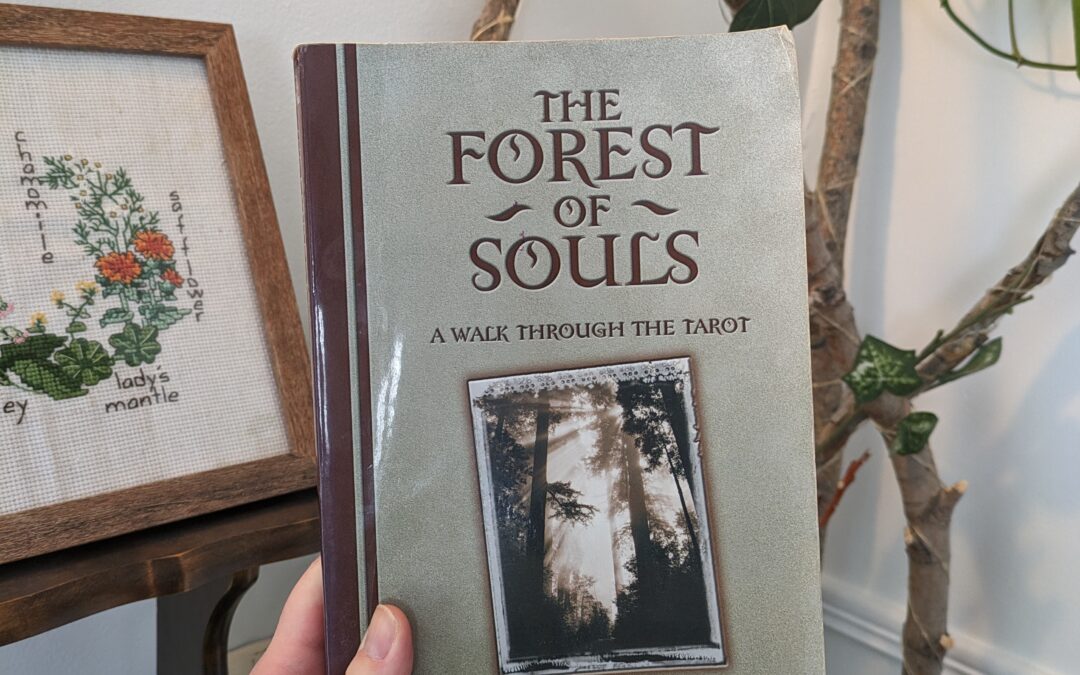
Entering the Forest of Souls (part one)
It is hard to put into words what Rachel Pollack’s insights mean to me. She is a shining inspiration for the way I want to be not only as a tarot reader, but as a human being. I did not know her well but was lucky to meet her and have lunch with her at a tarot conference in 2018. Although she passed last April, I have a hard time talking about her in past tense. Through her books and teachings, it feels like she is very much still here with us.
78 Degrees of Wisdom is the Pollack book which has had the most reach. And with good reason! That was one of the first tarot books I ever read and it blew me away. Not long after that I read Tarot Wisdom which I found just as good if not better than 78 Degrees. But it wasn’t until last year that I read an unassuming little book of hers that I hadn’t seen many folks talk about. That book is The Forest of Souls and it quickly became my favorite Rachel Pollack book and one of my favorite tarot books of all time.
I shared an activity from this book in a post a couple months ago (tarot, take me home) and also mentioned it in a note here on Substack, but I haven’t shared a full review. I guess even what I’m doing today is not necessarily a ‘review’ in the traditional sense. Instead, I want to wander through the pages and share with you some of the passages I have underlined. These words have become glimmers and beacons for me at a time in which I am much in need of glimmers and beacons. Perhaps some will connect with you as well.
“…unlike sacred books, or the works of psychological sages, the Tarot can change and become new every time we pick it up. This is because we can shuffle it. We can take the cards, with all their intense symbols, mix them, and lay them out as a new work.”
This has always stood out to me about tarot but I never knew quite how to put it into words. I expounded on this idea in another recent post (dark, light, gift) and I should have credited Rachel there for bringing this to the forefront of my mind. Tarot is always new!
The above passage comes from the beginning of the book and is brought full circle in one of the last chapters where Rachel plays with the idea of different numerical sequences for the major arcana. She reminds us that the earliest decks did not have set numbers for the major arcana, and even know there is some quabbles among tarot practitioners about what numbers each card should hold (most famously Strength vs Justice). Rachel honors the significance that has built up around the way we most commonly order the cards and how that has greatly influenced her own thinking and teaching – “and yet there is value in newness as well.”
Like many nuggets in this book, I could write a whole ass post just about this one topic. But I will reign myself in for now so we can take a broad view of the many rabbit holes Rachel offers here.
“…as far as scholarship can tell us, (tarot) began as a game. This may startle many people, especially those who have heard exaggerated stories of the Tarot’s mythic origin. The more I think about it, however, the more it appeals to me that these are playing cards. When we play, we can do so much more – we can allow so much more – than when we make everything solemn and literal.”
!!! I have always been a proponent of having fun with tarot. I taught a workshop at a local bookstore a couple years ago where most participants had little to no prior experience with tarot. I’ve noticed that newcomers sometimes have an inherent fear of interpreting a card the ‘wrong’ way. To dispel this in the workshop I had everyone pull a card and share the most silly or outlandish message it might hold. It led to much laughter, and hopefully a sense of playfulness those folks could carry forward on their tarot journey.
~~~
Next, Rachel gives a wonderful musing on the origins of tarot and our beliefs and myths about time. She suggests that perhaps we can consider time as a web instead of a strict linear trajectory. In this paradigm “the future can cause the past as much as the past causes the future… (or) neither one causes the other, they exist in a relationship that goes in many directions all at once.” From there:
“One use of a myth of time as a web is a way to imagine the origin of tarot. Suppose our collective beliefs about Tarot as the key of keys – Antoine Court de Gébelin’s ‘discovery,’ the Golden Dawn, our current psychological approach to the cards, whatever ‘future’ developments we do not know about – suppose all these beliefs somehow reached back in time to draw the Tarot into existence in Renaissance Italy?
We, all of us, caused the tarot to come into the minds of cardmakers in such a perfect form and structure that in our own time we can adapt it to an almost endless series of esoteric, mythological and cultural ideas.”
My jaw hit the floor. I just… love this. What an expansive, inclusive, and imaginative way to contextualize tarot’s development. This passage goes on to point out that future generations of tarotists may also be reaching back right now to us – you and me. What might they be asking us to draw forward? What evolution of tarot craft and function is whispering to you from 5, 10, 20 years forward?
~~~
Now, some musings on card meanings:
The belief that such meanings exist in the cards spurs people to find meanings the original designers may never have intended. Once found, however, those meanings exist.
This part spoke to me as a tarot deck creator myself. One of the most amazing things about releasing the Spacious Tarot into the world has been witnessing folks forming their own interpretations to our illustrations. People find such rich layers of meaning in the artwork, things that Annie & I weren’t even consciously aware of when we created the deck.
A most famous example is our Lovers card. When I came up with the concept, I described it as two light beams intertwining. But many people have pointed out that the image looks like a double helix, and that association has added depth to the card. As deck designers, we didn’t consciously intend this. But it has become part of this card’s spectrum of meaning through those that interact with the deck.
~~~
There’s an entire chapter devoted to the way tarot serves as an “instrument of our wisdom.” Rachel builds a particularly lovely metaphor for how tarot mirrors different types of music. This connected with me quite intuitively, as when I’m teaching tarot myself I’ve often compared reading tarot to being a jazz musician. Rachel takes this even deeper, drawing the following comparisons:
Occult tarot systems (such as the Golden Dawn & BOTA traditions) are similar to classical music in that they are structured, analytical, systematic and involve many rules, traditions and deep study.
Fortunetelling is the folk music of tarot. “Like folk songs, fortunetelling forumulars are simple and compelling and easy to learn,” Rachel explains.
Here’s the one I already brought up: Rachel describes an approach that may draw on some foundational/occult interpretations but pairs that with intuition and imagination as similar to jazz music. Obviously, this is where I am most at home.
There are also those who use the cards with NO knowledge or regard to their history or standard interpretations. Those who have never seen a deck before and simply start pulling cards with reckless abandon. Rachel suggests this might be the rock’n’roll of tarot.
~~~
At the heart of the book are several readings Rachel did on some Big Questions like: what is soul? What is tarot? These are special to read in their entirety but I simply must share this particular passage:
We are each a mysterious creature, unknown to ourselves as much as to others. We are hunters, fierce in our desire for meaning and love. Together we form a complex and dangerous landscape. The Tarot helps us move through that landscape. It allows us to look at ourselves, to see how lives fit together, and also what possible meaning lies behind, or inside, events.
I mean…tattoo that on my forehead.
~~~
Next we get into something I generally do not speak about due to my personal ignorance on the topic: tarot and Jewish mysticism. Being a tarot historian in her own right, Rachel Pollack is clear that the cards were not originally intended to tie into Kabbalah. And yet, “Judaism gives us a model on how to discover meanings ina mysterious work (and) the tarot certainly is a mysterious work.” She also believes a person does not need to be Jewish in order to find value in Jewish perspectives on tarot. If you have been turned off by overwrought occultist jargon parading as Kabbalah, you might find Rachel’s approach more down to earth.
~~
If you were to ask me to state one concept from Forest of Souls that is most likely to stick with me forever… well, that would be a very tough call. But it might be the concept of loving the images.
Rachel says this is how she describes her entire approach to tarot. It’s not about fixating on keywords, astrological associations, etc etc… although those things can have value. But ultimately, tarot cards are images. To truly engage with tarot, we need to truly engage with the pictures.
When we love the images, we do not run away from them. We really look at them, see what goes on inside them, for us, right at this moment, as if we face a new picture each time we look at it… approach (the images) with passion and excitement.
This dovetails perfectly with the earlier passage about tarot always being something new. This philosophy requires you to truly show up and be present each time you pull a card. No holding yourself at a respectable distance. Being fully present and engaged in what you see in each moment. This also goes nicely with the playful approach described earlier, too. Personally, some of the worst readings I’ve done happened when I was overthinking and having an inflated sense of self importance. The best readings always come when I have a light heart and freely roaming curiosity.
~~
My goodness, this is becoming quite long and I’m only about halfway through the book, so I will pause soon and come back another day with part two. But to round out part one, I leave you with yet another electrifying idea Rachel puts forth:
What if tarot existed before creation?
Among the more striking concepts in Jewish tradition is the suggestion that the Torah existed before creation. Supposedly, God created the Torah before the universe and then consulted it in order to make the world… …can we say something similar about Tarot? Can we play with the idea that the Tarot images that have proven so vibrant, so suggestive of so many systems and visions, actually existed before the physical universe?
This is a perfect example of what I love so much about Rachel Pollack. She brings an intellectual grounding and scholarship to tarot, while at the same time bringing unbounded mysticism and imagination. She presents the question of tarot existing before creation not as a literal truth, but as an evocative, perception-altering myth. And as Joseph Campbell said:
Mythology is not a lie, mythology is poetry, it is metaphorical. It has been well said that mythology is the penultimate truth–penultimate because the ultimate cannot be put into words…mythology pitches the mind beyond that rim, to what can be known but not told.
Of course, Rachel also turned to the tarot itself in her pondering. She asked the cards several questions, including: did the tarot exist before creation? How did God use the Tarot to create the world? She shares the cards she drew and the insights she found. Perhaps you might turn to your own tarot cards with these inquiries. Love the images and see where they take you.
Thank you for indulging my commentary so far! I’ll be back again soon so we can experience the second half of the Forest of Souls together.
Carrie
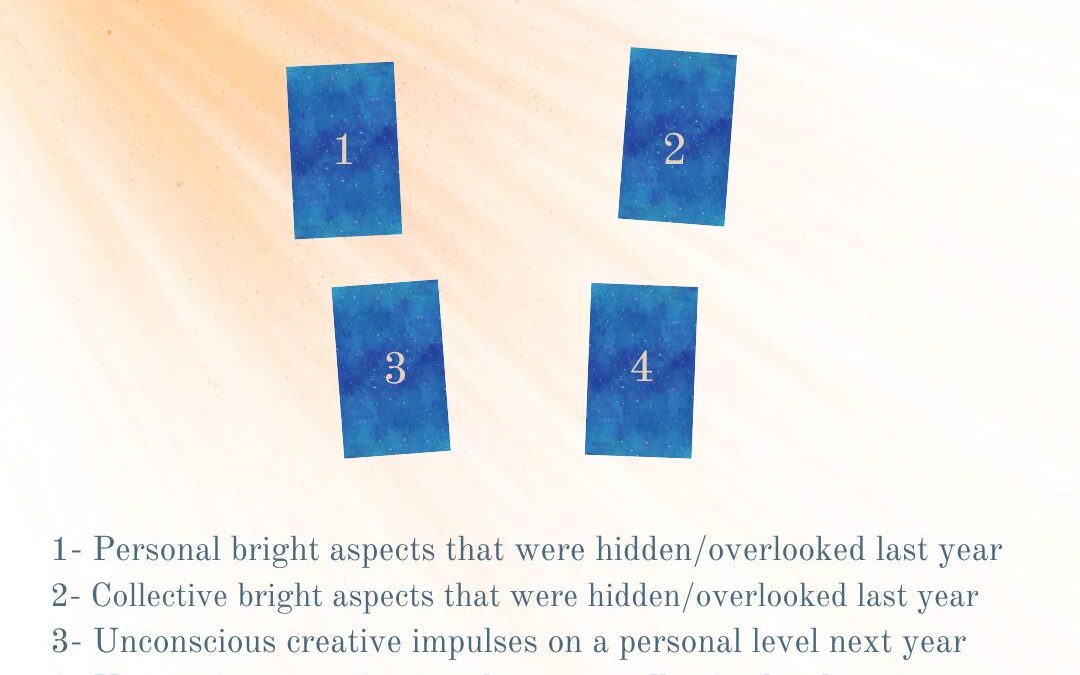
The golden shadow
I just finished reading Tarot Celebrations by Geraldine Amaral & Nancy Brady Cunningham, which caught my eye because it approaches tarot with a Jungian perspective. It’s a decent intro to psychoanalyst Carl Jung and how his ideas can apply to a tarot practice. I can’t say much in this book was super in-depth or revelatory to me, but I’m already fairly versed in this subject matter. If you’re new to Jungian concepts and how they relate to tarot I would actually recommend this over many other books.
One particular concept mentioned in the book really hooked my imagination and won’t let go: the golden shadow. The authors say: “this (is) Jung’s concept that the dark shadow has an equal counterpart: the bright or golden shadow which contains your highest potentials and abilities, the inner aspect of yourself which is your best and brightest aspects (which) may not yet manifest themselves in your life.”
My first reaction was, well yeah, I’ve been pointing out something similar for years and I’m glad to see someone else mention it! I gave a talk at a tarot conference a few years ago where I referenced a lot of Jungian concepts including shadow work. I stressed the fact that the shadow is not just scary darkness, we also tend to repress many qualities that could be magnificent. I didn’t use the phrase golden shadow because I’d hadn’t heard it yet, but I was getting at a similar sentiment and something I think is often overlooked in shadow work.
Shadow work is quite popular among tarot readers (shout out to Kelly-Ann Maddox who has taught on this topic for many years) so you’re likely familiar with the concept but in case not: the shadow, according to Carl Jung, consists of the aspects of your consciousness you repress, deny, or project onto others. Shadow work is a broad term that encompasses any number of methods for bringing the contents of your shadow into your conscious mind (such as journaling, therapy, pulling tarot cards etc). The idea is that you find a greater experience of wholeness by integrating the shadowy unconscious into the totality of your Self.
A lot of shadow work modalities focus on aspects of the shadow that are tricky. Which is kind of part of the package: acknowledging what is shameful or hurtful is a core part of shadow work. But, your shadow is not JUST darkness.
If it has been believed hitherto that the human shadow was the source of evil, it can now be ascertained on closer investigation that … (the) shadow does not consist only of morally reprehensible tendencies, but also displays a number of good qualities, such as normal instincts, appropriate reactions, realistic insights & creative impulses. -Carl Jung
Now, I will say that although I was familiar with these ideas I had never heard the term golden shadow until Amaral & Cunningham mentioned it. Upon some light Googling it seems like this is not, in fact, a phrase Jung himself actually used. One poster on a Jungian forum went so far as to call it an “unnecessary neo-Jungian invention”. Which, okay. But I still like it, and even if the phrase golden shadow itself is not of the Jungian canon, the general concept does seem supported by his work so I’m gonna roll with it.
Here we are on the cusp of 2023 unfolding into 2024. Any time is a good time to do some golden shadow excavation, but it feels particularly appropriate for this moment. If you’ve been following my writing lately, you may have noticed 2023 sucked ass for me. I feel awkward always vaguely alluding to this, but it’s not in anyone’s best interest for me to talk in more depth about it right now…suffice it to say, two of the worst situations of my entire life both erupted in 2023.
And if you’ve been existing as a human being with eyes and ears and heart you may know 2023 was extremely violent on a collective level as well. It was a shadowy, shadowy year indeed. A year that forced a lot of us into some devastating shadow work both personally + collectively (the collective shadow is something Jung wrote about as well). And that difficult shadow work is ongoing.
In the past I’ve offered elaborate spreads and in-depth workbooks for the New Year (anyone remember those?!). I come bearing something simple this year, but I hope it will hold you in feeling into your golden shadows. Because sometimes the tough shit seems all encompassing, we need to make a conscious effort to polish the hidden treasures as well. The contents of the golden shadow may currently be warped and buried; let’s begin to excavate and reshape them with tarot as our guide.
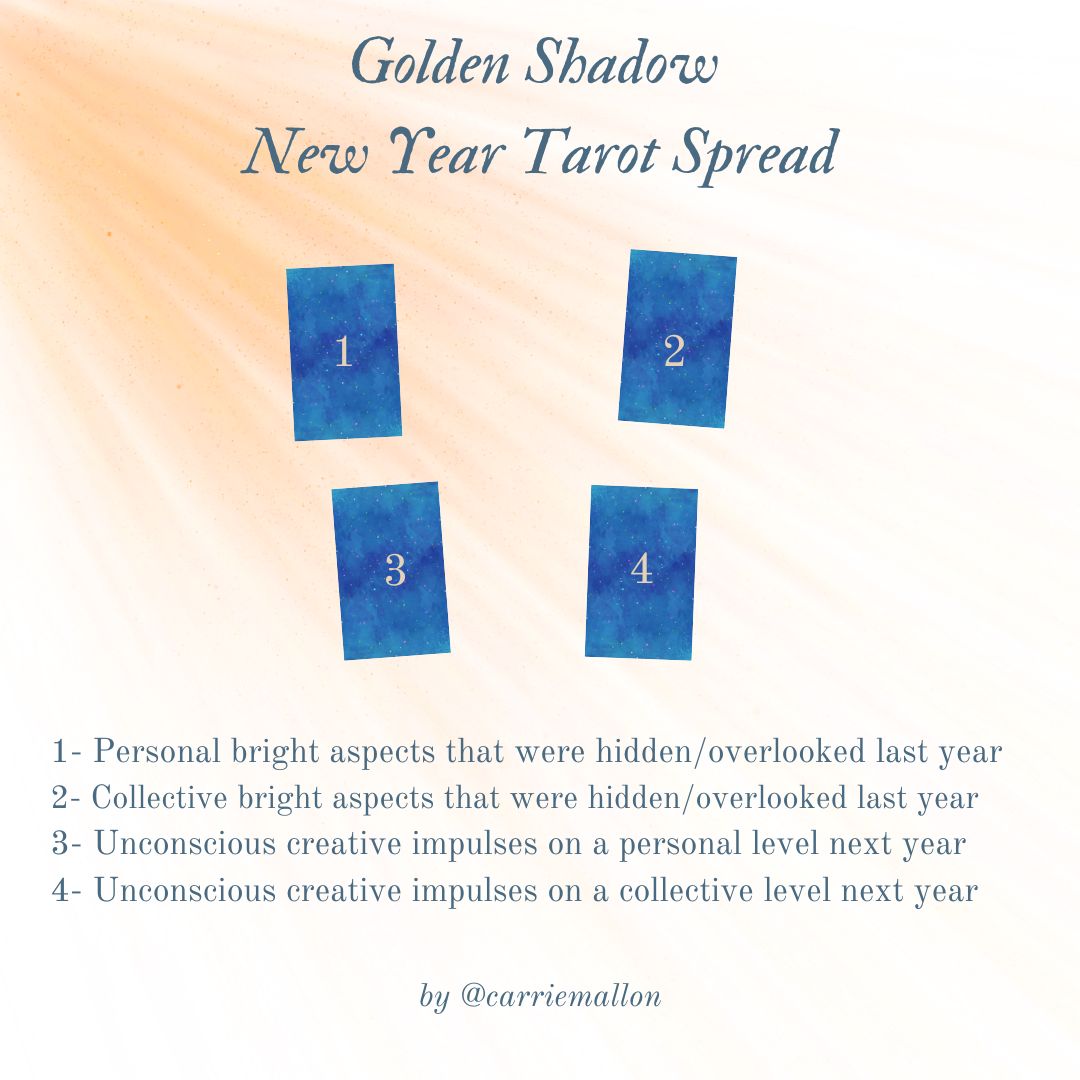
I have the Six of Wands to suggest bright aspects of my own personal self that were potentially overlooked or unconscious during 2023. Many people say the Six of Wands is about triumph, but Resiliency is the word that comes to mind here today. And it makes sense as I’ve never believed myself to be incredibly resilient. If you would have told me half the shit that was gonna happen in 2023 I would have said “wow, I’m going to crumple up and hide in a corner.” And I mean, sure, I’ve done that a time or two. But I’ve also had moments where I managed to sit down, like the person on the card, re-steady myself and tend to inner fires. That resiliency, once unseen, is something I’ve already started to acknowledge. This card encourages me to continue that process.
Here is our old friend the Eight of Cups who also showed up in the last spread I shared. This time it speaks to bright aspects on a collective level that may have been obscured or unacknowledged during 2023. Last time I used a phrase for this card which very much feels applicable again: new ways of being are always revealing themselves to you. Perhaps we haven’t yet grasped the final form of the new ways of being which began to reveal themselves during 2023. And that’s okay. After all, the end of a year is an arbitrary thing. Our lessons and revelations rarely fit tidily within a calendar year.
Perhaps right now even if we can’t fully understand the new ways of being 2023 drew forward, we can at least look for the small glimmers, and like the woman on the card, embrace the metaphoric moons as they continue to move into fullness.
Now we look at 2024, with the Emperor representing my own personal creative impulses, which may be unconscious, that perhaps I can integrate this year. This made me laugh because I have a narrative about myself that I am ~*ChAoTiC*~. But the Emperor, of course, brings chaos into order. Perhaps during 2024 I can look for fresh opportunities to do just that. In a way, it’s a continuation of a journey I’ve already been on. You know, I titled the first post I ever made on Substack “Chaotic ramblings” on a book. When in reality, it was a pretty well organized and thorough book review. The Emperor asks me to take greater credit for my ability to be structured, and to affirm that this type of order can actually create space for greater creativity.
The Three of Pentacles is such a wonderful card to complete this reading, representing unconscious creative impulses available to us on a collective level this coming year. I… actually can’t imagine a more perfect card here? People working together, but each in their own way, bringing their own talents and strengths into the fold. It’s such a delicious counter-narrative to the stories of cutthroat competition and winner-takes-all mentality which still permeate much of humanity. But it doesn’t have to be that way. How can we unearth the collaborative aspects of human nature this year and beyond? Many of us have already been asking this question, and perhaps 2024 broadens the depth and scope of our understanding.
So there we are! Another year in the books. Another on the horizon. Wishing you well truly, and I’m grateful you’re here.
Carrie
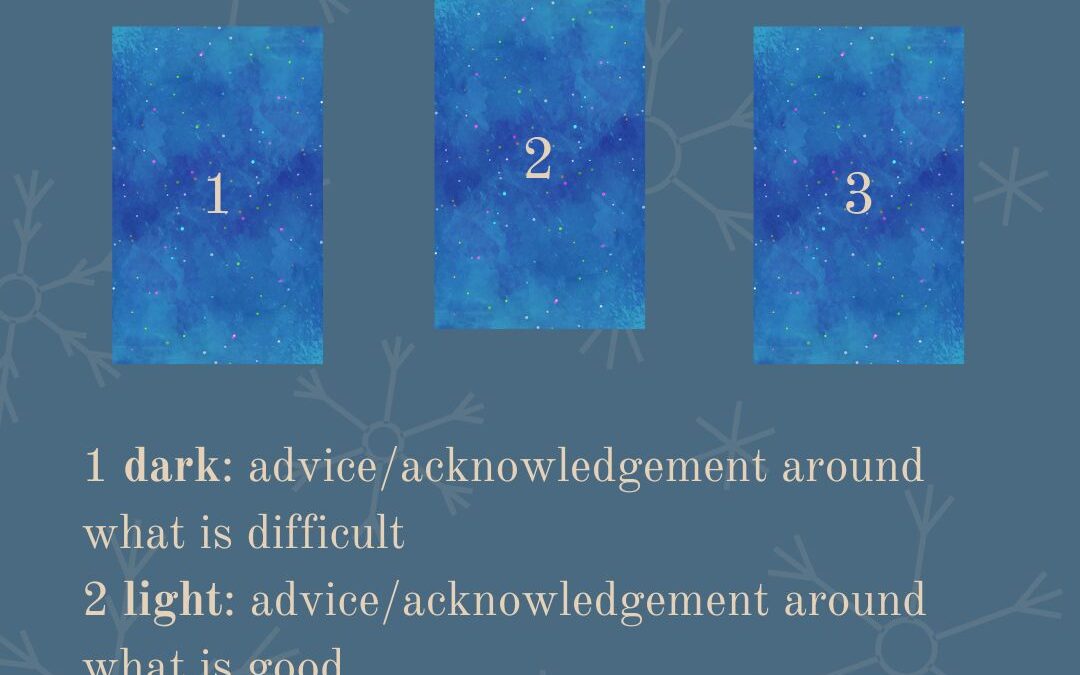
dark, light, gift: a winter solstice spread
The framework for a simple tarot spread came to me in the shower today (as interesting ideas often do). It’s a day late but this is somewhat solstice themed, and also more broadly winter themed. In the past I’ve been known to take on longer, more complex spreads for the solstice. But this year simplicity feels right. As I’ve been doing lately, I’ll pull some cards for myself and offer them up if they happen to ring true to you. Perhaps after that you’d like to try the spread for yourself?
Oh and also: I support rebellion, so if you’re in the southern hemisphere or stumble upon this post at a different time of year, perhaps you might still partake.
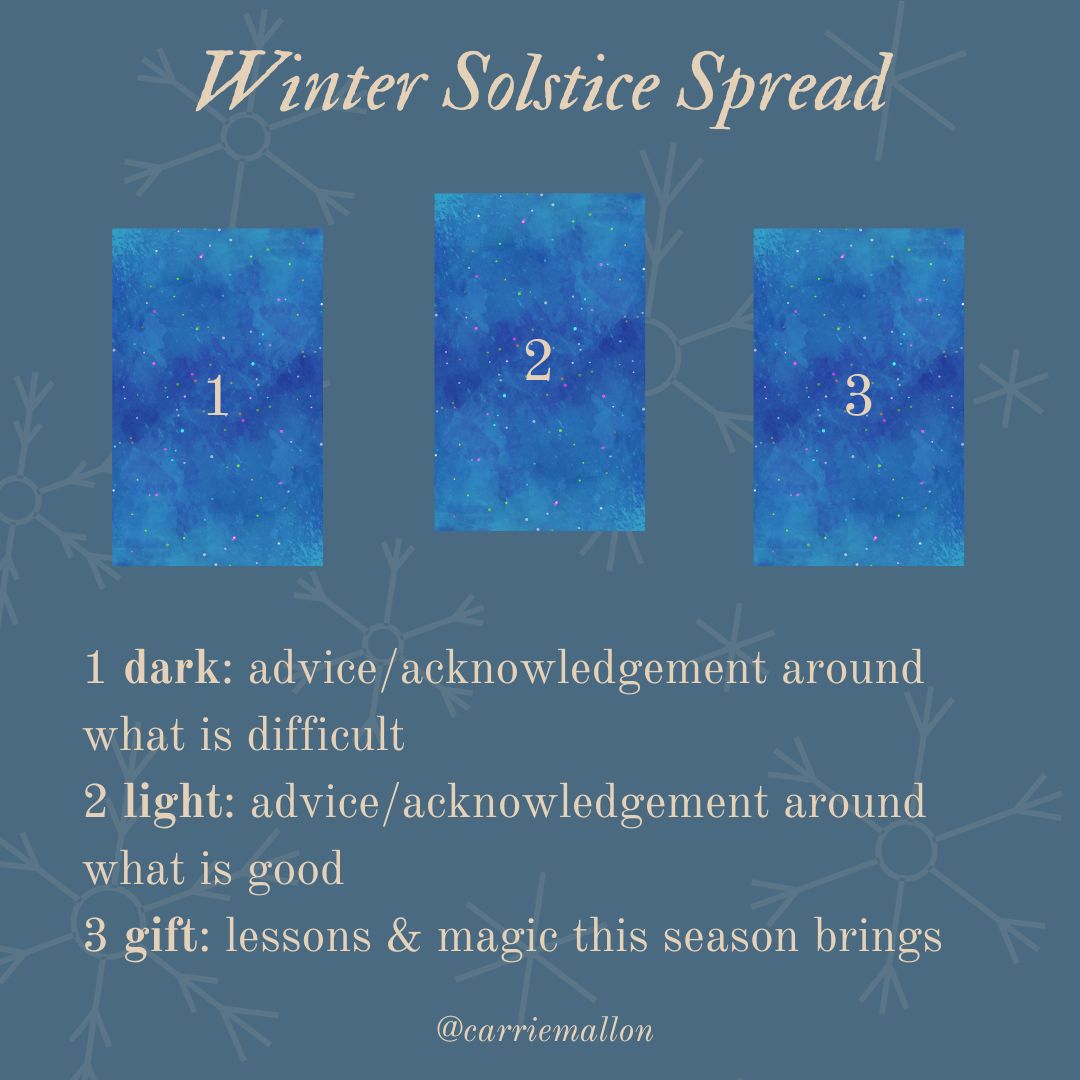
First, in the dark position, we have the Four of Swords. This…makes so much sense to me. What is difficult right now? Getting my thoughts in order. Maybe you can relate? It’s partly the season: getting and wrapping gifts, planning meals, winding down the year, making lists and checking them twice.
In a broader view, it’s difficult to make sense of the entire damn world right now. Four is a number of structure, swords are the mental realm. So the Four of Swords can be about understanding. The ability to explain something clearly. That moment when everything clicks into place and you have a clear picture.
That’s not my experience of observing the world right now, though. Things seem extra violent and dark. As much as I crave a clear understanding, it isn’t there. Many things do not make sense. There is no solid theories to explain the way things are.
But even though this is the ‘dark’ position, in a way I think this is a good thing too. Sometimes the most powerful thing you can do is say “this doesn’t make sense, I don’t understand this, and I’m never going to.” Our human minds like to have rationalizations for everything. Going against that urge to rationalize something that truly cannot be rationalized is difficult but at times necessary.
For light, we have the Eight of Cups. This phrase comes to me:
new ways of being are always revealing themselves to you.
I certainly believe this. In fact, this is an undercurrent that is always present in my tarot practice. Tarot itself is always new. You see the same cards but always revealed in a new context: a specific spread position, next to a contrasting card, in a different deck. You see the same cards but in one instance you are more drawn to a color, or a particular aspect of the composition, or a subtle symbol you’d overlooked previously. Tarot is always new, and it is always revealing new ways of being.
This card is very welcome, especially after the more rigid messages of the Four of Swords. The imagery for this card is still dark, but the crescent moon winks at the new ways of being that are always emerging. At the same time old ways of being fade away. Something is always concealed. And lately, I think I’ve been directing too much energy towards what is concealed. Because at the same time, something is always revealed.
So what exactly is this light? What precisely is this new way of being that is revealing itself? I WANT TO KNOW. I want to define it (Four of Swords energy still at play, am I right). But the Eight of Cups now feels less about identifying a new way of being in a definitive way, and more about being open to how this organically flows. This isn’t something else that can be added to the to-do list we mentioned earlier. It is something that only comes from openness and presence and feeling into what draws you.
In the gift position I have reversed Five of Pentacles. My lord. I believe the gift here is: you don’t have to carry everything alone. None of us do. The imagery for this card shows a lone wolf with an injured leg scaling a muddy hill. But there is support visible on the horizon. In this moment it occurs to me that the wolf is close enough to make some noise and be like “HEY! You up there. I need help.” And maybe that help is just waiting to be summoned.
In the ‘dominant culture’ we still encounter a lot of messages of ‘rugged individualism’. Like, life is hard but just pull yourself up by your bootstraps and you’ll make it through! Even those of us who have done some work to dismantle these messages can still sometimes have moments of shame that we aren’t able to keep pushing up that hill. So maybe the gift is the willingness to shout out: “this sucks and I need help.” Let someone listen. Let the support come to you. Hell, demand the support come to you if you have to.
And the reversal of the card makes me think the gift goes both ways. Isn’t the Christmas season, in theory, supposed to be about helping those in need? So if you’re the one who HAS the resources to offer, do that. If you know someone is struggling don’t wait for them to ask. Choose something specific and give it. I cannot recall where I came upon this advice, but the idea is that when someone is in dire straits it can be difficult for them to form a request. So instead of something open ended like “how can I help,” specificity is key (“I’ll bring a pot of soup Wednesday” or “I’ll make tea and sit with you for an hour tomorrow”).
Did that sound too lecture-y? I do not enjoy sounding like I’m giving a lecture when I’m reading tarot, but sometimes it comes across that way. Phew.
So there we have it. De-centering the urge for rationalization. Feeling into new ways of being as they take shape and form. Asking for and offering support. A few messages to carry into the season. They are useful for me and I hope they may be of value to you as well.
Truly wishing you the best this solstice and beyond, friends.
Carrie
Gratitarot: an old concept & a new spread
Many moons ago (probably like 2015?) I hosted a community event on Instagram based on a concept I came up with called Gratitarot. The idea is very simple. Gratitude + tarot = gratitarot. In its purest form, to practice gratitarot you simply draw one card and use it as a prompt to consider something you’re grateful for. I’ve been revisiting that practice this week, maybe partly because we just passed Thanksgiving in the US (say what you will about that holiday, but I’m never gonna shit on an opportunity to be grateful).
Gratitarot got a boost in popularity a few years ago when the wonderful Katey Flowers shared it in a video, but I’m sure there are many of you who haven’t yet come across this idea so I wanted to share it a little more in depth with you now. Most notably, I’ve created a new tarot spread I’m going to share and test drive today.
Why practice gratitarot now? Well, this fits the vibe of what I’ve been sharing in general lately, really. I’ve been writing from the heart with tarot and asking tarot to take me home and generally gravitating towards gentle and nurturing ways to connect with my cards. That’s where I’m at these days, and based on the sweet messages I’ve received from some of you, I know I’m not the only one.
I’m sitting here trying to describe how I define gratitude and I still agree with the way I wrote about it in 2020:
Here’s the type of gratitude I’m not about: the type of gratitude that is forced, that is non-specific, that is about bypassing real issues and “just being positive.”
Here’s the type of gratitude I AM ABOUT: the type that is deep, specific, and viscerally felt. Gratitude like this isn’t about forced positivity, but it is about challenging your ego’s tendency to fixate on dumb shit instead of really noticing the magic and beauty everywhere. Gratitude can coexist with a desire for change. Gratitude can coexist with acknowledging what is wrong or painful.
Instead of bypassing the tough stuff, gratitude gives you an anchor into something deeper, something primal and mystical, a force that keeps you afloat amidst the tough stuff. Gratitude is about noticing all of the tiny miracles that surround you in each moment and amplifying them.
As I already said, if you are craving exquisite simplicity, shuffle your cards and pull just one. Use that to describe in as much detail as you can muster something you’re grateful for. When you’re ready to expand this practice, here is the new spread I’ve crafted:
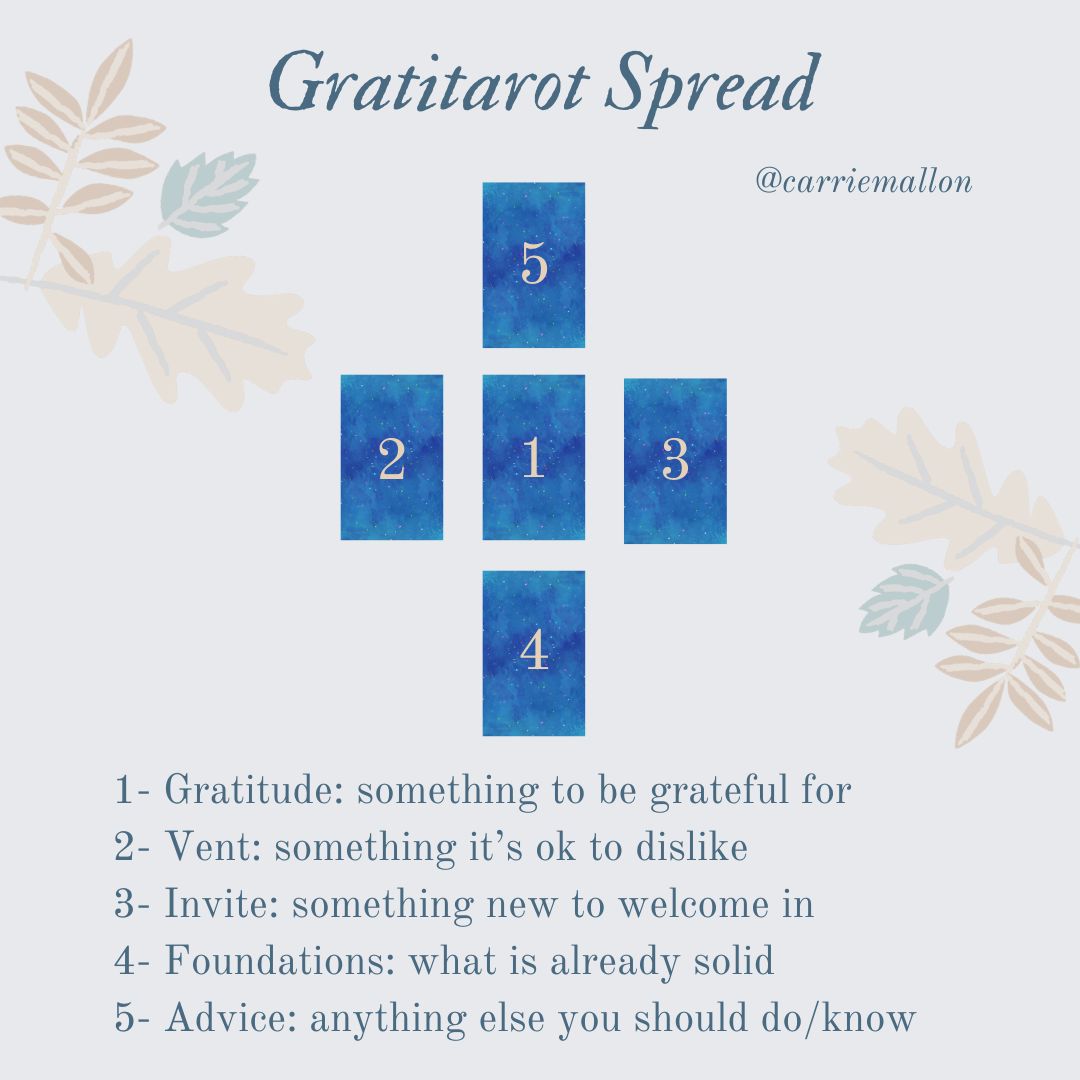
Let’s give it a whirl. As usual, I’m pulling cards for myself but offering messages that may resonate for you as well. I’m using the Pastel Waite-Smith Tarot.
As I was about to lay out the first card my chonky ginger cat, The Squash, came sashaying over, flitting his tail in my face and asking for attention. I reached around him to look at the card and it was the Knight of Wands. Now I’ve never considered giving my cat a tarot significator but this is too much of a synchronicity to be ignored. I mean, look at his tail and the plume on the knight’s cap. They’re practically twins.
I was expecting something more profound, but is this card reminding me to be grateful for my cat? Hmm. On second thought, what is more profound than that? The bond we share with our animal companions is unparalleled. This reminds me that I have a social worker friend who works with suicidal patients. She says that by far the most common reason people give for deciding to continue living is their pets. Imagine that.
I’m lucky enough to have four furry companions and while they do bring an element of chaos into my life (which is also on brand for the Knight of Wands) they also infuse my days with so much enthusiasm and adventure. I am sincerely grateful for them and I appreciate the Knight of Wands and the Squash providing this reminder.
The next position brings some balance in. Even though we are focusing on gratitude, that doesn’t mean we can’t name what sucks. So I have the Magician in the vent position. I recently watched the first episode of White Lotus and there’s a scene where a husband is having a cancer scare and the wife says something like “you’re going to be fine, good things happen to good people.” I’m sure the writers intended this to be a cringey line and it is indeed, and it reminds me of a shadow aspect of the Magician.
Personal power is a theme commonly ascribed to this card. We have the power to create our own reality, or so some people believe. Like attracts like. As above so below. If you put out good energy you manifest good things. And so on. Look, there is some truth to this. But there’s also a whole lotta BS. Sometimes good things do happen to good people. But sometimes bad things happen to good people. And good things happen to bad people. And the things that happen to people don’t always have something to do with them manifesting them. You can’t control everything.
I actually went on a related rant on threads not too long ago where I said “more ‘spiritual’ teachers need to talk about the fact that there are forces in the universe that have nothing to do with you. Not everything is a lesson or message. Not everything is a result of your ‘manifestation.’ You are a component of the universe, not the center of it.”
Next we have the King of Pentacles suggesting something new to invite in. What stands out to me here is how thoroughly devoted the King of Pentacles is to their own realm. There’s a wall behind them, suggesting boundaries. The city in the distance is visible, so it’s not that this King isn’t aware of things beyond their realm. But they are grounded quite contently on their own throne, tending to their little corner of the world.
When I was younger I believed that I could ~*change the world*~. As I get older and more mature, perhaps the King of Pentacles invites in a more realistic view of my sphere of influence. This doesn’t mean I should ignore situations outside of my domain. Not at all! It’s more about deepening into what is actually and truly mine to hold. It’s about cultivating practicality. Not a cold and distant practicality, but a grounded and embodied practicality.
This ties in perfectly with one of my joy guidelines, a set of principles I created for myself to live by. One of them is “take the next small step.” That’s what the King of Pentacles does. She lays the groundwork. She listens. She weighs her energy and abilities. And THEN she moves. So I’m inviting in some gratitude for and awareness of the fact that when a small step is taken with intention, it can be more impactful than an urgent sprint.
Next I have the Knight of Cups in the foundations position. So many court cards! The message that immediately came to me with this one is “your heart is in the right place.” That actually… almost made me cry? My heart is in the right place. Sometimes I doubt this. I think this card is here as a wash of comfort and affirmation. It’s as simple as that.
The Two of Swords rounds things out, bringing any other advice that may be beneficial at this time. This is somewhat outside the traditional interpretations for this card, but I believe it is asking me to pay more attention to my dreams. Maybe even analyze them. Because to be honest, I have been having nightmares lately. Once I wake up, I’m kind of like the figure on this card, putting on a blindfold and trying not to think about them.
What if I went beyond that fear? What if I used the powers of my mind (swords) to explore the watery depths (kept at a distance from the person on this card)? What if I trusted myself to find interpretations of my dreams that are useful and liberating? What if instead of being something fearful, I could find gratitude for these dreams? This is possible, the cards remind me.
There we have it. A gratitarot spread. I hope the spread offers you something meaningful should you try it for yourself. You are welcome to comment or email me to let me know (I can’t always reply to every message, but I receive them and they mean a lot to me).
I am grateful to YOU for being here.
See you next time,
Carrie

Tarot, take me home
The Forest of Souls by Rachel Pollack immediately became one of my favorite tarot books when I read it earlier this year. There are so many wonderful gems, my copy is adorned with underlines and notes. Lately I keep thinking about a passage where Rachel describes being in a difficult time and turning to her tarot cards without any particular spread in mind and saying “take me home.”
It’s not entirely dissimilar from Mary K Greer’s method of writing from the heart with tarot that I referenced in my last post. Both of these approaches to tarot are alluring to me as I continue to find that I’m personally in a tender place, and I think it’s safe to say we are collectively in a tender place as well.
An aside: in my last post I mentioned I’d soon be sharing a piece on gender and tarot. And yeah I thought that’d be out by now… would’ve been nice since it is Trans Awareness Week (HAPPY TRANS AWARENESS WEEK!) but it’s turning into a long one which requires research and brain power, and my brain power is in short supply these days. It’ll be done at some point!
Anyway…tarot, take me home. This feels like exactly what I need right now so I’m going to try it and share whatever comes up with you. I’m using the Spacious Tarot. The Four of Swords, Guardian of Wands & The Emperor have arrived in this moment.
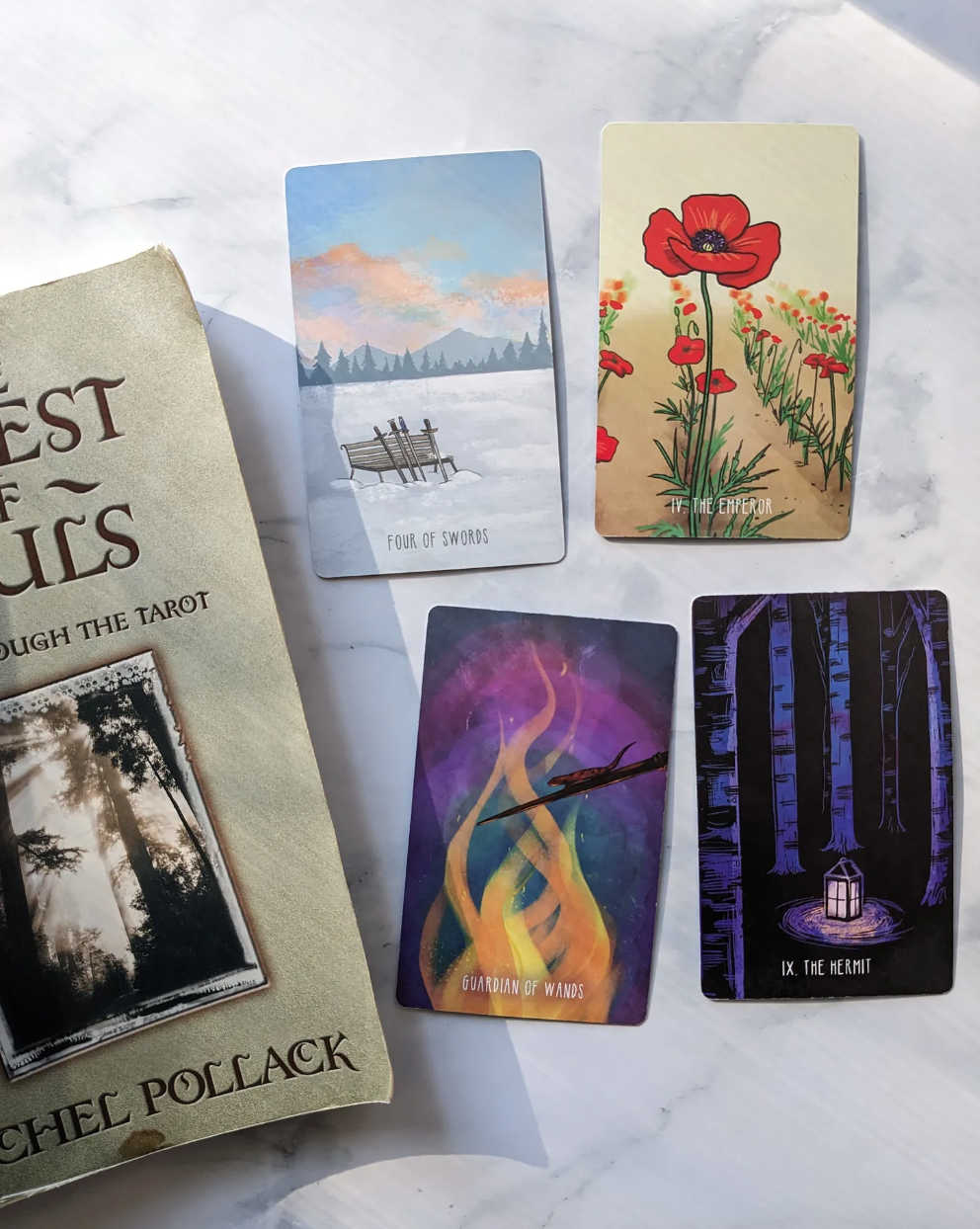
Four is a number of structure, and I have two fours here. So to begin this brings up the question: what is home? More specifically, what is the structure of home that we’re referring to when we ask tarot to bring us home? That is a multifaceted shimmering question as the best questions are.
Obviously, home has a physical level. The four walls you dwell within, the society (or ‘empire’) you belong to, the planet that sustains you. So at the onset perhaps the cards ask: how are you tending to your physical home?
The Guardian of Wands brings this question into greater focus because she tends to a flame, the heart of the home. What is the heart of your home, on all levels, micro and macro? How are you tending to the heart of your home? Where have you been neglectful in your care? What asks for more fuel? There’s a reminder of gratitude here too. At least for me. How lucky am I to have a physical home? I have a semblance of safety. I’m not displaced. That in itself is immense.
There is a vibrancy to the Guardian of Wands and it suggests that tending to your home is not just a chore. It is a joy, or at least it should and could be a joy. What changes does that require? To tend not out of obligation, but out of love? That might mean big shifts in exactly what it is you tend to. Enough caring about dumb bullshit. Time to attune to what actually gives brightness and warmth.
I suppose there is a shadow side to all this too. Because once you move beyond your insulated little home and reach the society level, there’s probably gonna be shit going on that you don’t endorse or agree with but it happens in your name. What do we do with this? It’s different for everyone. Protesting, maybe. Resistance, maybe. Being a radiant, glowing, self-assured example of a different way of being? THAT’S A YES FROM ME.
Sometimes when I look at tarot cards song lyrics randomly come into my head, and looking at these ones I started singing ‘for a minute there I lost myself’ from Radiohead’s Karma Police. All of these cards feel like an invitation to find myself again. What does it mean to come home to yourself? In what ways have I lost myself, and how might I begin to find myself?
I find the Four of Swords is particularly meaningful to these inquiries. We have that stable number four, and swords, the suit of the mind. I am attempting to come back home to my own thoughts, opinions and perspectives. Not in a rigid way. I always want to remain open to other views and new information.
But lately I’ve been entirely too immersed in external ideas: the 24/7 news cycle, the constant bombardment of social media… you know how it is. The noise can be disorienting. I can get concerned I’ll say the wrong thing, or that I don’t know enough, or that someone will misunderstand me (pointless concerns because all of these things will and do happen regardless; they’re part of life and I can survive them). Or worst of all, I get too wrapped up in what everyone tells me I should think to actually…think for myself.
I used to be better about this: journaling, meditating, writing. Articulating my thoughts with care, yes, but not with relentless editing. I’ve strayed from this – for a minute there, I lost myself. Now I want to make intentional space to gather my thoughts like swords on a bench. So that I can take up the space that is mine. Not intrude on someone else’s space, not try to fit into a space I’m actually not suited for. But to assertively inhabit the space that is mine, as the Emperor does at its best.
The interplay of all three of these cards is fascinating in that there is a calmness, but also a boldness. That interplay of calmness and boldness is the energetic space I want to exist within: it is home.
At this point I decided to pull one last card because hey, the number four has been a major theme so adding a fourth card to the mix seems right. And I have the Hermit. A cozy synchronicity that this entire reading is inspired by a book called The Forest of Souls and this Hermit card could be an illustration of such a forest.
Earlier we talked about home as a defined structure in the outer world. The Hermit emphasizes that home is also an internal space. Home is a space within where there is no rush, no expectations, no pretenses. And if you’re into Jungian psychology, home can extend beyond your personal unconscious and into the collective unconscious. In this way, the internal space of home is not isolated. It is solitary, to be sure. But it is still a place of humanity and connection.
The Hermit & The Emperor together remind me of a quote from the poet Novalis: “the seat of the soul is where the inner world and the outer world meet.” I referenced this quote in a post I wrote back in 2018 (which, interestingly, was also about the theme of finding home). At that time I described home as the seat of the soul and that still feels relevant now.
This is an example of how in a broader sense, taking us home is what tarot always does. Tarot is a way for the outer world (the physical cards you lay out) and the inner world (the musings, neuroses and insights the cards evoke) to come together. This is why I always return to the cards. Tarot guides me to the seat of my soul – tarot takes me home.
Sending love always,
Carrie
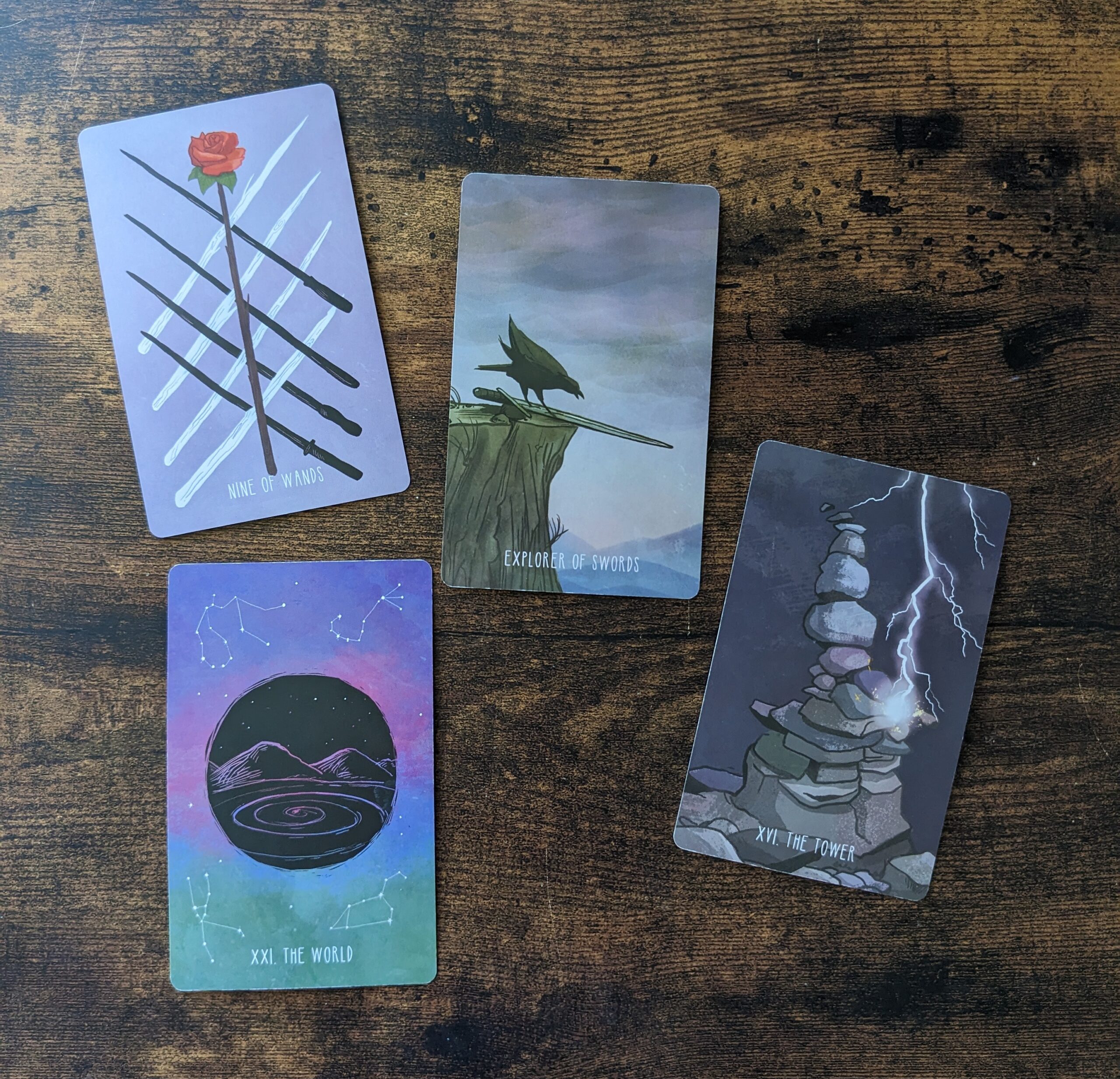
An unnerving storm
Sharing directly from your heart isn’t always calm, clear and articulate. I want it to be. But sometimes sharing directly from your heart is an unnerving storm.
Mary K Greer has this simple but wonderful method for writing from the heart with tarot. I’ve done it many times and figured I’d do it again today. This wasn’t what I had planned. For my previous two pieces, I took more of an educational angle with an in-depth book review and a discussion on tarot history and the Chariot. I wanted to do something similar today. Teach you something, or share some type of tarot lore.
But I just don’t have it in me right now. Ten minutes ago I was in tears and said to my husband “everything from the biggest issues in the world, wars and genocide and mass shootings, down to the smallest and dumbest minutia of my life, is overwhelming and depressing right now.” It is hard to shift from this into, like… “hey here’s a post on how to read reversed tarot cards!”
Part of writing from your heart with tarot is setting an intention for your writing and today as I shuffled my personal copy of the Spacious Tarot I thought “help me find a message that might be useful to myself and maybe someone who reads this.”
Sometimes when I pull tarot cards they do give answers, help things click into place. Other times, they don’t necessarily illuminate new information but they do something that can be just as vital: they validate what I’m currently thinking/feeling. That’s what the cards are doing today.
The Nine of Wands has me thinking about the theme of protection. Because honestly, I’m not really sure about publishing this post. I think writing more ‘educational’ pieces is a form of protection. Part of why I stopped blogging so frequently is it can feel uncomfortable exposing my innermost thoughts to the world. It feels safer, more protected, to be in teacher mode.
Then it has me thinking about protection as a broader theme. Like how the pretense of protecting yourself/your nation can be used as a justification for unimaginable violence.
Next I pulled the Explorer of Swords. It’s me, shouting into the void. Sometimes that’s all you can do. So here I am.
This card also has me thinking about how sometimes when terrible things happen in the world, we pick apart how others are reacting. And by this I mean we look out for what our friends or celebrities or ‘influencers’ are saying or not saying on social media. I think this can be positive. The whole ‘silence is violence’ thing has some merit. Speaking up can make a difference.
But at the same time, I think sometimes I’ve fallen into the trap of monitoring what other people are saying because it maybe creates an illusion of control. I can’t control what world governments are saying or doing and that is beyond frustrating. So maybe getting mad over what a B-list actor or a tarot reader with a small following is saying (or not saying) is a way to unconsciously project some of that anger.
I’ve been taking a lot of solace in the writings of Dr. Jaiya John lately. He recently wrote:
“Rather than policing other people’s grieving or the language they use to express it, attend to your own grief. So that you do not become yet another destroyer. We dearly need you to be in Love. Outside of love there is no life at all.”
And another one:
“A word may seem like a meaningless thing when confronted with atrocity. But it was words and the absence of words that created the atrocity. Dehumanization is a story fed to souls. You must tell your rehumanizing story. You must tell it with your whole life.”
Of course, I also pulled the Tower. OF COURSE. Sometimes I think the Tower shows up just to validate that, yeah, shit’s bad. It was a particularly affirming card to pull today. No one wants to be in Tower energy. But the only thing that’s even worse than being in Tower energy is being there and believing there’s something wrong with you for feeling the way you do. I think this card showed up for me today just to validate, yeah, things are awful right now, let’s not sugarcoat that.
I don’t always do this but occasionally I’m drawn to check the card at the bottom of the deck, which I did just now and it was the World. A sweet balm.
The World reminds me that We Are One. This isn’t merely some spiritual platitude, damnit. It is a poignant and complex spiritual concept in many different lineages, to be sure. It’s a scientific fact as well.
Today this card brings to mind a beautiful sentiment Danielle Coke Balfour recently shared on Instagram. She said:
We’re feeling it now. The tugs on the strings that tie us together. From Palestine to Sudan, from Yemen to Congo, from Israel to Ukraine, the arms reaching out for freedom & refuge pull on our heartstrings…. This tug is asking something of you. Will you create? Write? March? Pray? Connect? Read? Call? Feel? Give? The decision is yours. It doesn’t always have to feel “big” to be meaningful. It doesn’t have to be “loud” to be heard. It doesn’t have to be public to be legitimate. It just has to be yours.
The beauty of this is, when I’m pulled one direction, you may be pulled in another. This is humanity. It’s how we cover ground. Don’t let your dissatisfaction with someone else’s response distract you from where your tug leads you. Just go. It all matters. It’s all felt.
What a gift it is to be connected to each other.
Well, that made me cry again. But in a way tinged a little less with despair, a little more with hope. Thank you for being here with me today as I shared something more personal. I hope something here resonates with you but if not there is a whole wide internet out there so go forth.
I’m already working on an outline for my next piece, which will be back to more tarot-centered teachings. And I’m excited but nervous because it’s gonna be a verrryyyy big & maybe controversial topic: gender and tarot. See you then.
Carrie
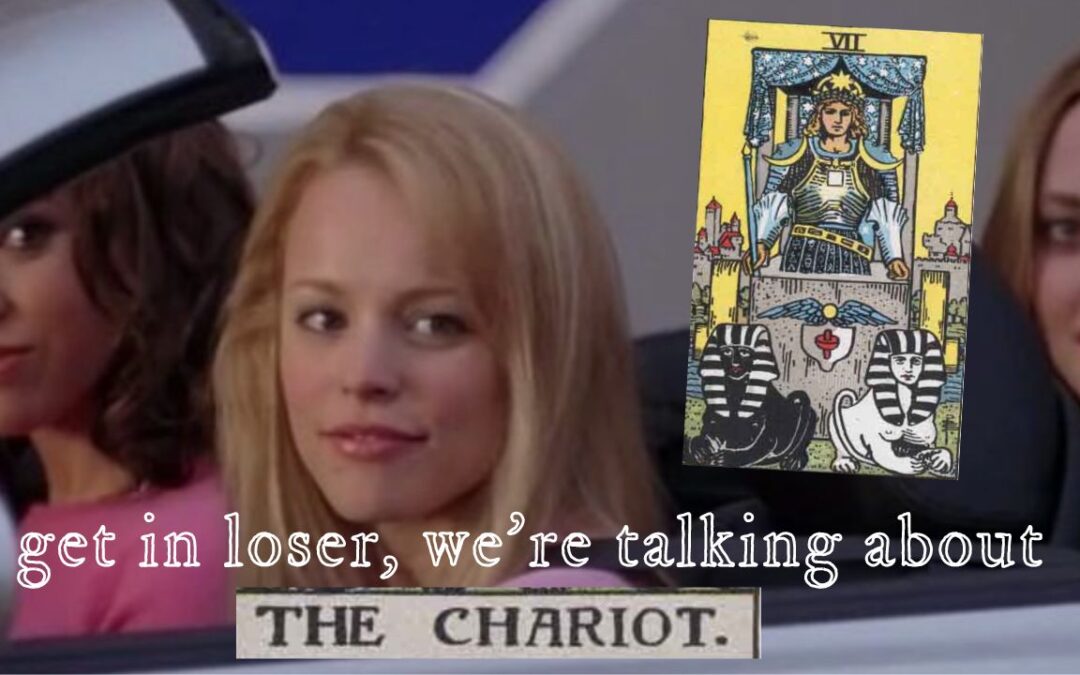
Finally addressing the Chariot
Remember how back in January loads of tarot readers were sharing perspectives on the Chariot? Because according to the numerological method developed by Angeles Arrien, 2023 is a Chariot year (2+0+2+3 = 7, the Chariot). I’ve talked about this concept of collective year cards many times, so if you’ve been following me a while you might have heard this preamble: year cards aren’t something I’m super into. Numerology isn’t something I’m super into.
BUT- here’s something I love about tarot: if you’re open, you can find a way to powerfully and potently relate any card to any situation. So even if there isn’t some synchronistic mystical power connecting the Chariot and the year 2023, we can certainly find ways that this card is perfectly suited to this moment in time.
I said I was going to chime about the Chariot back in January but haven’t yet, oops. It’s October and I’m fashionably late but there’s still time so LET’S GO.
Part One: Origins + Evolution of the Chariot
My last piece focused on tarot history, and it so happens that the Chariot says more about tarot history than perhaps any other card in the deck.
The oldest surviving versions were titled ‘Il Carro Triumphale’ or the Triumphal Chariot. ‘Triumphs’ were a sort of parade, originating in ancient Rome and re-popularized during the Middle Ages and Renaissance. In Rome, this was a show of military strength and hierarchy. The triumphs were led by prisoners, then would come the captors and ultimately the generals. The Renaissance versions were less military focused and more about general pageantry and celebration, drawing upon various cultural and religious elements. In the booklet accompanying the Golden Tarot, a re-creation of the Visconti-Sforza deck, Mary Packard writes:
Gleaming horse-drawn chariots filled with well-known heroic and villainous figures were accompanied by singers, dancers, and performance artists…. sometimes, Renaissance triumphs featured performers who embodied Plato’s virtues. Uniting the basic hierarchical form of the triumph with themes that were complex and allegorical in nature, these pageants presented a procession of virtues, each triumphing the other in importance.
Triumphs would have been familiar to the general public at the time the earliest tarot decks appeared and the Chariot card in particular – and perhaps even the entire major arcana – seems to be a nod to this. As we did last week, it’s time to once again shoutout to tarot historian Gertrude Moakley who was the first to point out many of these connections.
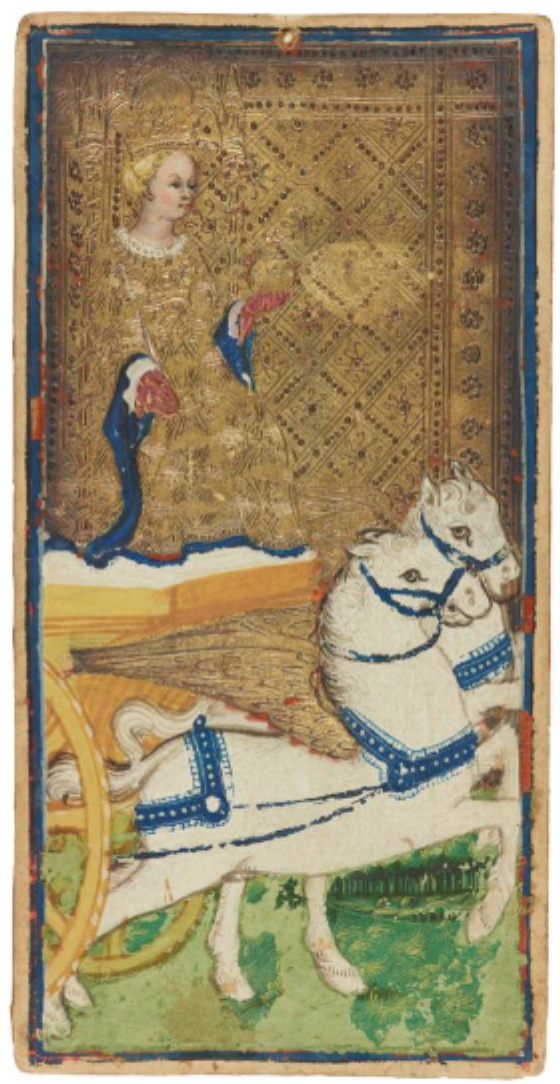
The Chariot card from the Visconti-Sforza
The Visconti-Sforza tarot was commissioned as a wedding gift for Bianca Maria Visconti, the daughter of a Duke, and Francesco Sforza, a military leader/mercenary. Of course this was a strategic marriage, orchestrated to increase the status of both families. Soooo yeah, one of the earliest tarot decks has its roots in hierarchy and imperialism.
Some tarot historians (starting with Gertrude Moakley) believe this original Chariot card shows Bianca Maria herself, but she seems to be taking on the role of Laura, the woman who inspired Petrarch’s famous poems I Trionfi. Mary Packard writes:
“As driver of the chariot, Laura displays multiple symbols of authority, including the golden crown on her head, the scepter carried in one hand, and the imperial globe held in the other. Enacting the Neoplatonic quest for immortality, Laura manifests as archetype for the hero. She must exert her will over the winged horses – one of which represents the Soul of Appetite and the other, the Soul of Will – as she guides the entire chariot/soul toward enlightenment.”
It’s difficult to see the scepter and globe in the above image as they’ve faded some from the originals, but they are visible in versions of the deck that have been restored.
I guess we need to talk about Plato a bit more. In Phaedrus Plato compares the soul to a Chariot with a driver and two winged horses, the same metaphor referenced by Packard above. A dark horse to represent the Soul of Appetite (or desire), the “lowest” part of the soul. A light horse to represent the Soul of Will (or Spirit). And the Charioteer represents the Soul of Reason, the “highest” aspect of the soul who directs the others. As we talked about last week, Plato’s work was trending during the Renaissance and does seem to have crept its way into the tarot.
It was 19th century occultist Levi who transformed the horses from earlier decks into sphinxes; the Waite-Smith tarot shows sphinxes as well. This was an attempt to highlight the supposed Egyptian origins of the tarot that early occultists proclaimed. It’s also interesting to me that the earliest cards showed a female Charioteer, some of the Marseille variations appeared gender nuetral (imho), but by the time Levi and Waite created their versions the Charioteer becomes male.
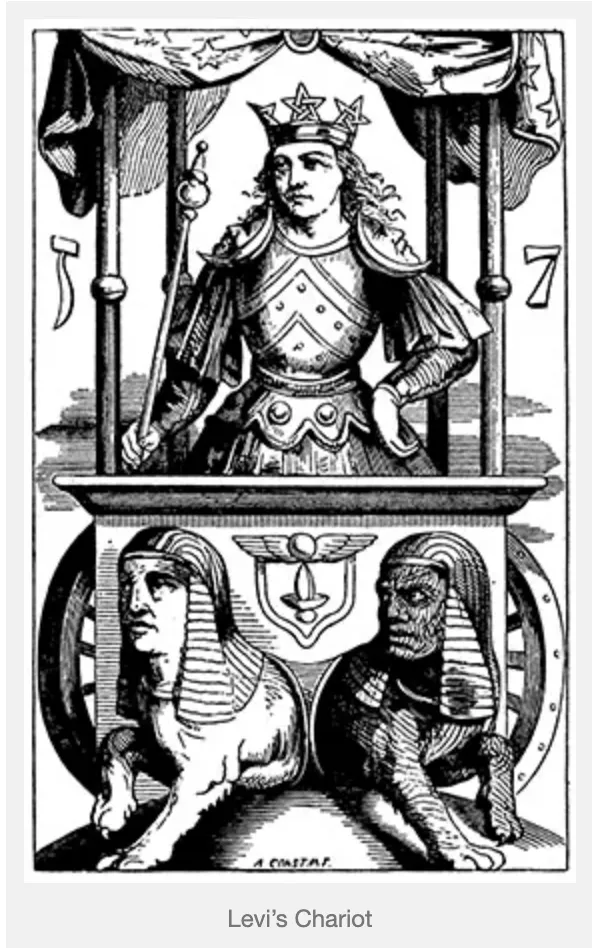
Image via robertmplacetarot.com
I’m currently reading Mystical Origins of the Tarot by Paul Huson which I bought because Rachel Pollack references it often in Tarot Wisdom. Most notably, Huson tracks the way the interpretations of cards evolved from the earliest occultists through Waite and the Golden Dawn. These interpretations don’t always line up with what we now know about the actual history of the card, because the occultists were not interested in (or even aware of) the Renaissance origin of the tarot and had their own fanciful theories about the cards.
Per Huson, Court de Gébelin described the Chariot as “Osiris triumphant.” Paul Christian continued this line of thinking, interpreting it as “the Chariot of Osiris, victory, a war chariot, an armed conqueror….the two sphinxes symbolize Good and Evil, one conquered, the other vanquished, both having become the servants of the Magus.”
In the Pictorial Key to the Tarot, Waite writes:
“He is above all things triumph in the mind. It is to be understood for this reason that (the Chariot) is concerned with a mystery of nature and not of the world of Grace, to which the charioteer could offer no answer. The planes of his conquest… are external and not within himself…the initiation he has passed in triumph is to be understood physically or rationally…if he came to the pillars of the temple of the High Priestess he could not open the scroll, nor if she questioned him could he answer.”
I think we see some of Waite’s ideas reflected in more modern interpretations, in many ways I think Rachel Pollack expands these thoughts in 78 Degrees of Wisdom. This was one of the first books I read on tarot and it has been instrumental in my understanding of this card. Rachel says:
“When we look at the cards sequentially we see 7 is only the victory of the first line of the Major Arcana. It crown’s that line’s process of maturation, but by necessity it cannot address the great areas of the unconscious and super-conscious. Seen this way the Chariot shows us the developed ego…the mature adult successful in life…able to control feelings, and above all, to direct the will.”
I can’t find the exact passage right now, but I believe it was also Rachel Pollack who pointed out that some people never move past the Chariot-level of development. Many commentators have compared the Chariot to Carl Jung’s concept of the persona – the curated ‘mask’ a person shows to the world. There is, of course, nothing wrong with developing a persona. In fact, it is essential to existing in this world. But in Rachel Pollack’s view of the three rows of the minor arcana, the second and third delve more into the nuances of the inner realms, as well as cosmological universal forces. Some venture there, some prefer the allure of stable identity and success represented by the Chariot.
Part Two: The Chariot & Me
Now that I’ve shared some historical context, I will divulge more about what the card means to me.
My intro to tarot was Learn the Tarot by Joan Bunning and there’s a specific angle she takes with the Chariot that has stuck with me all these years. Bunning uses the phrase “hard control” to describe this card. She views The Chariot as forming a pair with Strength, which is a “soft control.” There are other cards in the major arcana that are commonly seen as a pair (like the Magician/High Priestess, Emperor/Empress, Sun/Moon) but Chariot/Strength is not one you see all the time. I think this is a useful way to consider the cards, though.
At its worst, this “hard control” harkens back to some of the early influences of military conquest and hierarchy. Sometimes the Chariot is about making shit happen no matter what (or whom) gets trampled along the way. Whereas Strength is about patiently wrangling with something instead of forcing it into submission. As Bunning puts it, “there are many types of wins; the Chariot’s is of the win-lose type.”
Bunning also talks about will power as a key concept to this card. As someone who often feels scatterbrained and unfocused, this is an aspect of the Chariot that beckons me. I think about how much easier life would be if I was able to focus. If I could make decisions and move singularly towards them. If I had a concrete idea of who I was and what I wanted and moved pointedly in that direction.
As with any card, there’s a spectrum of potential (term borrowed from Arthur Rosengarten) in the Chariot. I try to avoid over-simplifying this as ‘positive and negative’ but there are ways that Chariot energy can be beneficial, and ways that it can be harmful. Chariot energy can inspire a healthy sense of identity and usher you forward to accomplish meaningful things. Or it can turn you into Ayn Rand.
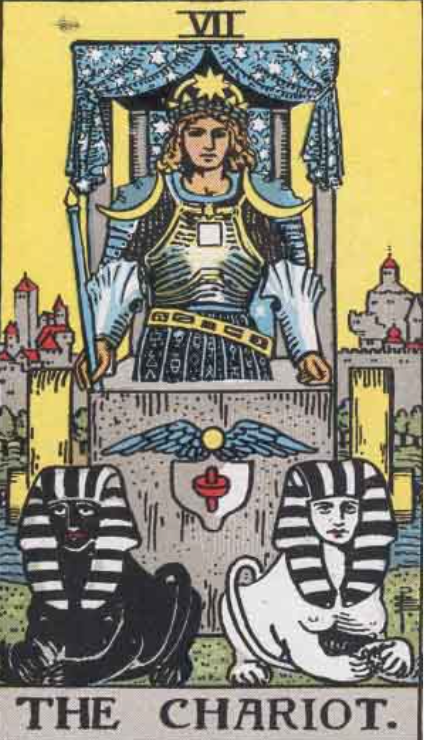
The Waite-Smith is the deck I started out with, and while I’m not going to break down every symbol here I wanted to mention what stood out to me the most as I learned tarot. That is the black and white spinxes, and how they seem to be going in different directions. Beyond the Platonic interpretations mentioned above, it’s always spoke to me of the necessity of managing any number of conflicting factors. Like… your practicality establishes one direction, but your passion veers you off course. Somehow you as the Charioteer need to navigate all this paradox to chart a singular course.
In writing this post, I’ve taken on the dreaded task of revisiting some of my old writings (fun fact about me: I want to disappear into a black hole every time I re-read something I wrote). I still quite resonate with how I wrote about the Chariot for my Wild Unknown blog series back in 2014:
I like to think of the Major Arcana as three sets of seven cards (with the addition of the Fool). In this view, the Chariot is the last card in the first row. In some ways, this card reminds me of a young adult, someone who has certainly matured but may have a narrow view of their overall growth. The Chariot speaks to a dogged determination to go in a certain direction, but on the shadow side Chariot energy can sometimes become TOO pushy and forceful…
There are many cards that speak of ease and flow, but the Chariot shows a counterbalance to these concepts. The Chariot is about determination, hard work and grit. In a metaphoric sense, you are a charioteer and the chariot you drive is your life. You have a responsibility to assert your control over that chariot and to take ownership over the direction you are headed.
The Chariot draws your attention to you and your path. This is a common theme in the visual presentation of this card in various decks. This card asks you to stay in your lane, to be aware of what YOU are doing. A shadow side of this can be selfishness and inflexibility. But at its best, Chariot energy brings you in touch with your most powerful autonomy.
There’s still something appealing about all of this to me, especially this idea of having SOME ability to direct your own life. Sometimes the external world and my own goddamn brain are so chaotic that I feel like I’m just being pulled along on the ride.
And maybe I am. The actual sphere of control for most of us is pretty small (and obviously varies depending on our unique privileges or lack thereof). I acknowledge that. But the Chariot is a reminder that there are some ways you can take the reigns, if you chose to do so. It reminds me of a quote I came across many years ago but can’t find the exact source: “I want to walk through life, not be dragged through it.”
When I finished writing this section I took a break and opened Instagram (as one does). The top post in my feed was from Chani Nicholas and this line got me: “all systems of supremacy bank on us forgetting how powerful we are! May we reclaim our agency!” This perfectly encapsulates what I’m trying to say here, and it brings us full circle from the card’s origins in conquering, into a more modern take on the Chariot’s potential to recalibrate our autonomy.
When creating the concept for the Spacious Tarot, I attempted to convey how the energy of the Chariot feels to me instead of relying on traditional imagery. So we ended up with something pretty different from the Waite-Smith or any of the earlier decks for that matter.
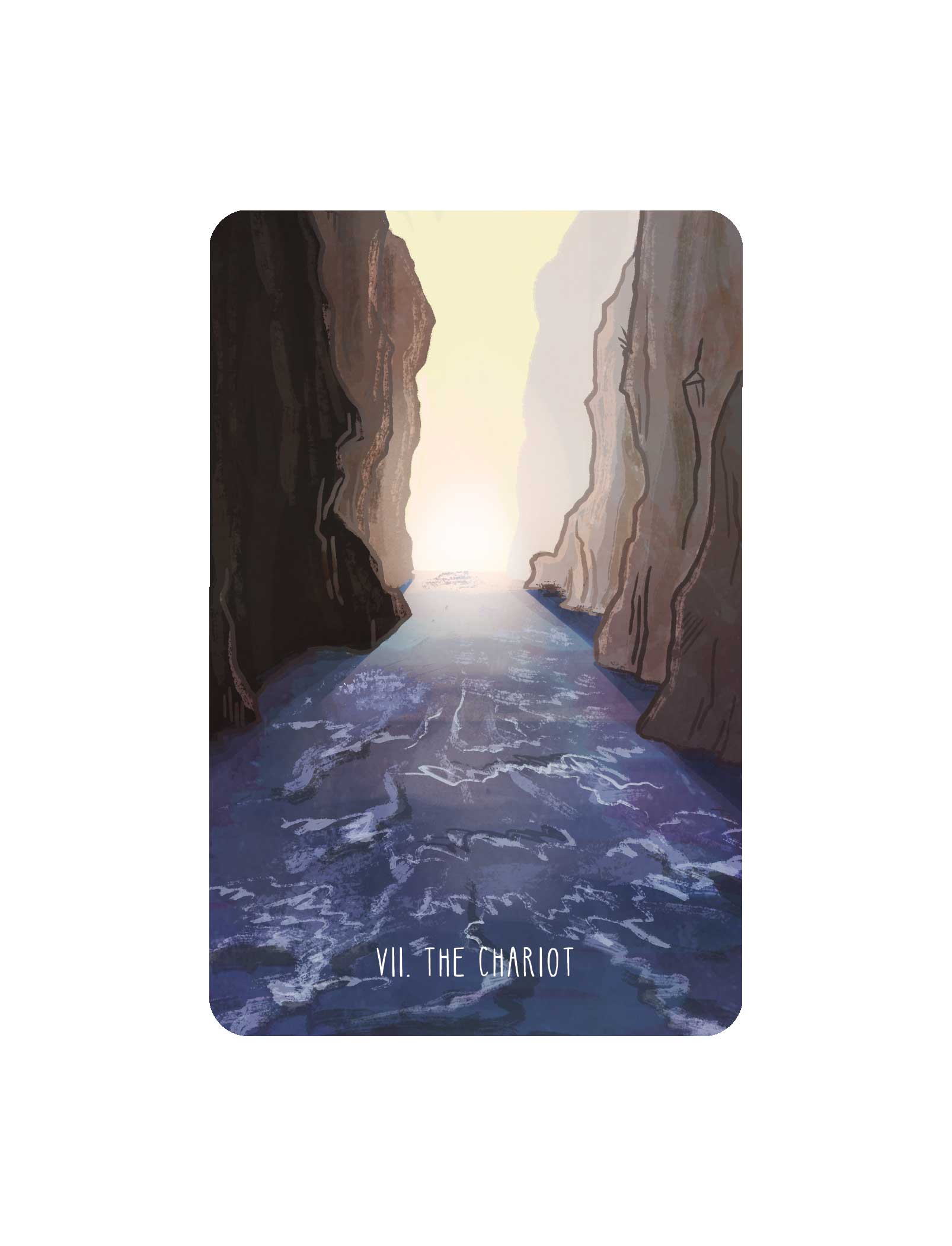
One time I was wading near the edge of the Colorado River and stepped in a little too far. The current grabbed me and I panicked for a moment because I could not fight against it. I managed to grab a tree branch and pull myself out before I got swept away, but I’ve never forgotten that sensation. It’s part of why this imagery came to me. I picture the determination it takes to press forward against a (metaphorical or literal) current and move towards the light on the horizon. And the power of something as simple as water to carve rocks and canyon walls.
This was more of a synchronicity than something intentional, but I like that we ended up with water in our version. The Chariot relates to Cancer in the astrological system used by the Golden Dawn. This has always been odd to me as I am a Cancer Sun and I see very little overlap in the zodiac sign and the tarot card. It’s one of the reasons I only toy with linking tarot to astrology and have never made it a pillar of my practice. Nonetheless, Cancer is a water sign and it pleases me that we have water in our depiction of the Chariot.
With the first person perspective we emphasized that the Chariot is about forward movement. I have a tendency to get moored in nostalgia and over analyzing the past. Sometimes that’s okay. But the Chariot echoes the expression “don’t look backwards, you’re not going that way.” ONWARD!
Part 3: The Year of the Chariot, 2023
I have the benefit of hindsight since I’m writing this closer to the end of 2023, but have been jotting down some notes for this post throughout the year.
Before we go further here, I want to tell you that I’m not going to be talking directly about the violence in Palestine in this post. I’m giving what I can to Doctors Without Borders and I echo what Chani Nicholas went on to say in the post referenced above: cease fire now. This horror intensified after I’d outlined much of this, and I believe it would be in poor taste to focus on it in the context of this post.
I wrote this sentence down at the beginning of 2023 when thinking about themes the Chariot might present this year: “identity, when to reaffirm vs when to soften out of it, moving beyond what your ego is comfy with.”
This has certainly been applicable for me this year. There’s parts of my identity I’ve been consciously trying to strengthen, like: I identify as a writer. A tarot practitioner. Solidifying that thru starting this Substack. Meanwhile, there are other parts of my identity I’ve loosened my grip on.
Some journaling prompts you could try for yourself: how has my identify shifted in 2023? What do I identify more with? What do I identify less with?
Earlier in the year I listened to an interview with Jarod K Anderson and he said something that connected some of the Chariot + 2023 themes for me:
“A lot of people who I feel like are not wrong, are calling for various kinds of revolution and deconstruction. And I don’t think that’s wrong. But I also think that if your thing is, say, industrialization of farming, and food production, and all of the consequences of it, I want to know more about how you feed everyone than how you destroy the industrialized farms. I just kind of feel like those insidious fingers of our cultural narratives, sneak in to even our well-meaning narratives of progress, because the destroyer is romanticized and the healer, and the grower, and the caregiver is not in so many of the dominant narratives.”
The bold part is what got me: the destroyer is romanticized. In fact, it reminded me of the origins of the Chariot, the Roman generals being celebrated for killing and imprisoning. That could be something to examine personally + collectively this year.
Who are the destroyers you’re romanticizing in your personal consciousness? And who/what are the destroyers we collectively romanticize? How can we direct our focus more towards solutions + healing? How can we keep shifting towards where we want to go instead of obsessing over the obstacles to that path?
A few months ago there was a sound trending on TikTok of Elyse Meyers saying “I don’t think there’s anything I couldn’t do at least half decently. I was born with the ‘how hard could it be’ gene, which is incredibly helpful and very delusional. It’s made me pretty lucky.”
This is total Chariot vibes, and as someone who was NOT born with this gene I want in on it. Since the Chariot is also about willpower, I suppose it’s fair to say I’ve been trying to will myself to develop this gene (moreso the helpful parts than the delusional parts). This harkens back to the ONWARD themes, the light on the horizon. How hard could it be to get there?
2023 has been a very difficult year for me personally, and the Chariot has been relevant in the way I’ve tried to just…keep going. Check my silly little emails. Go on my silly little mental health walks. Make incredibly simple to do lists just to feel like I’ve accomplished something. The Chariot isn’t always big and bold. Sometimes it’s just taking the next small action even when life seems completely overwhelming.
Well my friends, there’s always more to say but this seems like as good of a place to close things out as any. Thanks for takin’ a ride in the Chariot with me. I am sending you the very best wishes as we continue to move forward, forward, forward. Talk to you again soon.
Carrie
Carrie Mallon
Header art from The Spacious Tarot illustrated by Annie Ruygt
All site content © Carrie Mallon LLC 2014-2019
Sign up for weekly updates
